The Costa Blanca is a famous stretch of coast in southeastern Spain, where a warm Mediterranean Sea bathes an infinite diversity of white sand beaches and pebble bays encircled by distant mountain peaks. Follow me on a journey down the coastline, an insider’s Alicante travel guide to Costa Blanca in Spain.
Guide to Costa Blanca Beaches and Coastal Towns (Spain)
With a stunning 175 beaches along the Costa Blanca, and 20 coastal towns to visit, there is certainly a lot to see and do!
What to See and Do on the Costa Blanca in Spain
Original text by Kali Marco who lives on the Costa Blanca.
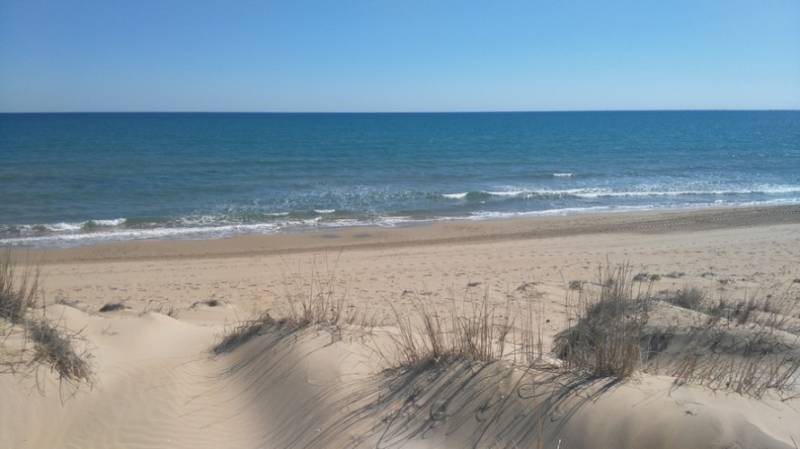
Here’s a quick description of the beaches and coastal towns of Alicante Province, followed by sections on activities and outdoor sports, walks and nature parks, info on how to get to the Costa Blanca, gastronomy and fiestas, and a little local history!
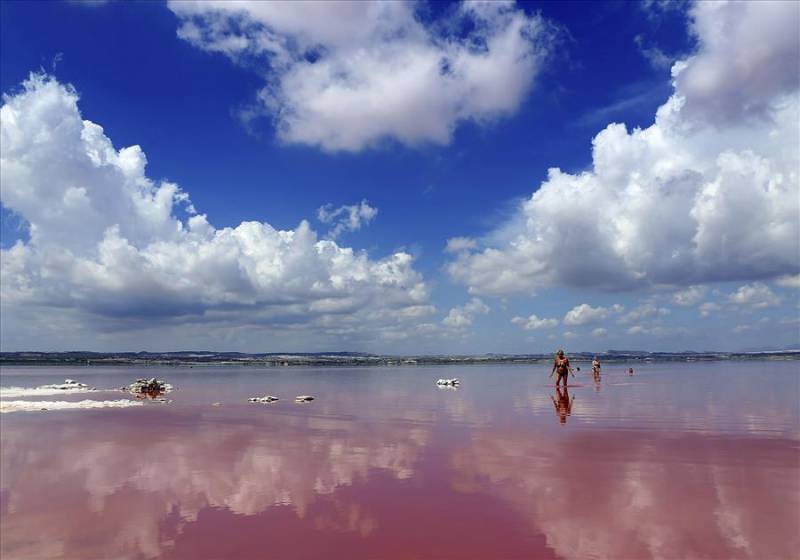
Well-known throughout Europe, holidaymakers come back time and again. With over 20 major seaside resorts, and some 175 beaches and coves on the Costa Blanca, that’s hardly surprising! But Spain’s gorgeous ‘white coast’ is much more than fun and sun … delve into the inland valleys or hike the hills and you’ll see what I mean.
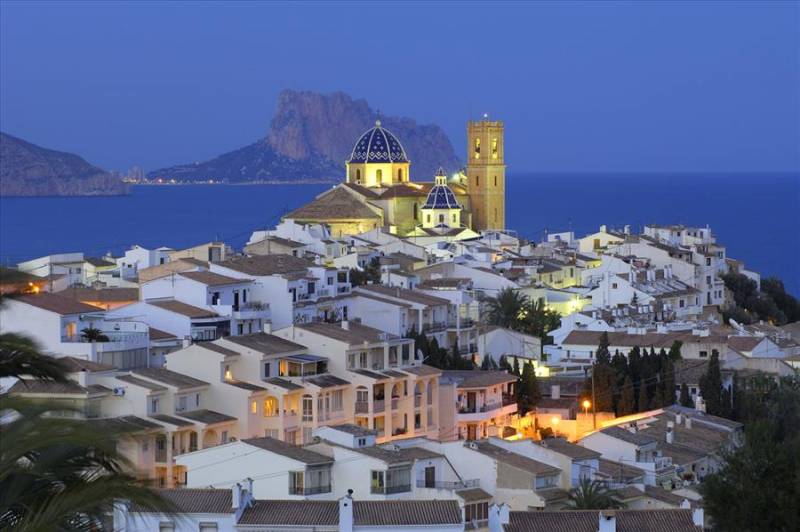
The province of Alicante has so many interesting places to discover, secret gems that few tourists see – cliff walks, hidden coves, mountain trails, riverside paths, monumental cities and traditional villages, as well as numerous activities and festivals. And we’ve not even mentioned the castles and vineyards yet. The Costa Blanca is one of the most popular tourist destinations in the world, and millions of Europeans spend their annual holidays here each year.
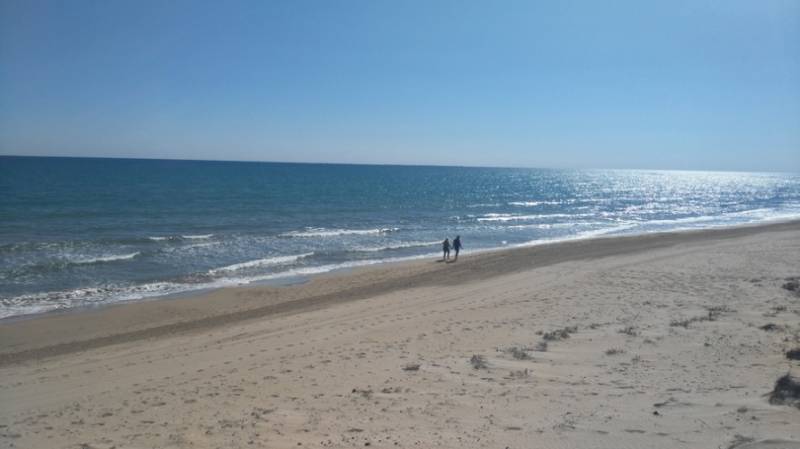
Just as I love travelling to other continents, visiting the monuments and temples, enjoying the countryside and beaches, trying new cuisine and seeing different cultures, I believe there must be lots of you out there who would love the chance of an insight into the place where I live… the Costa Blanca in Spain. Dare to dream and come over sometime soon!
Travel Guide To Costa Blanca (2025)
Peruse the list of coastal towns until you find your ideal beach or ‘Jump’ to a section of the Costa Blanca Travel Guide that interests you most!
Table of Content
- Costa Blanca Coastal Towns and Beaches from North to South
- MARINA ALTA
Dénia – Jávea – Benitatxell – Teulada-Moraira – Benissa – Calpe - MARINA BAJA
Altea – El Albir – Benidorm – Finestrat – Villajoyosa - ALICANTE Area
El Campello – Alicante – Tabarca Island - VINALOPÓ BAJA
Elche – Santa Pola - VEGA BAJA
Guardamar – Torrevieja – Orihuela – Pilar De La Horadada - Dog Beaches on the Costa Blanca
- MARINA ALTA
- About the Costa Blanca
Climate, Wine Tourism and Gastronomy, Historical Castles - Water Sports on the Costa Blanca
Best Dive Sites, Snorkel, Yacht Clubs, Marinas - Outdoor Sports & Activities on the Costa Blanca
- Golf on the Costa Blanca
Cycling Routes, Best Walks and Treks, Paragliding, Rock Climbing - Costa Blanca Protected Nature Parks
- Inland Costa Blanca
- History of the Costa Blanca
Archaeological Sites, History Museums, Lighthouses - Festivities and Costa Blanca Theme Parks
- Useful Information Costa Blanca
- How to Get to Costa Blanca
Transport, Driving, Airports, Shuttles, Bus, Train, Ferry, Car Hire, Distances - Chart of the 175 Beaches and Coves on the Costa Blanca
- Costa Blanca Tourism Boards
- How to Get to Costa Blanca
Sit back, read a little background history, explore Alicante’s white coast and virtually visit the beaches in this guide, then plan a dream trip to your favourite destination.
Costa Blanca Coastal Towns and Beaches from North to South
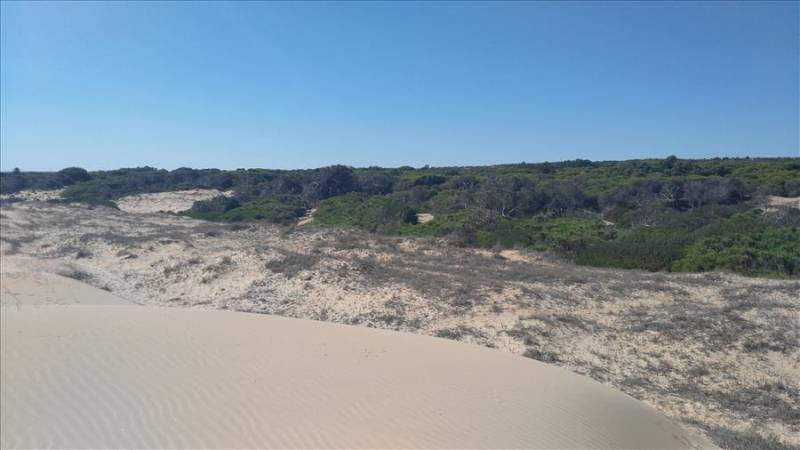
The Costa Blanca starts in Dénía and follows the Mediterranean Sea southwards to Pilar De La Horadada, more than 170 beaches and coves spread out over the 244 kilometres of coastline that makes up Alicante Province in southeast Spain. The region is divided into ‘comarcas’ or sub regional areas which are signposted in Castellano ‘Spanish’ and the Valencian language.
* See a Chart with a Full List of Costa Blanca Beaches at the end of this post.
Northern Costa Blanca – MARINA ALTA (Marina Alt)
DÉNIA – 19 kms coast
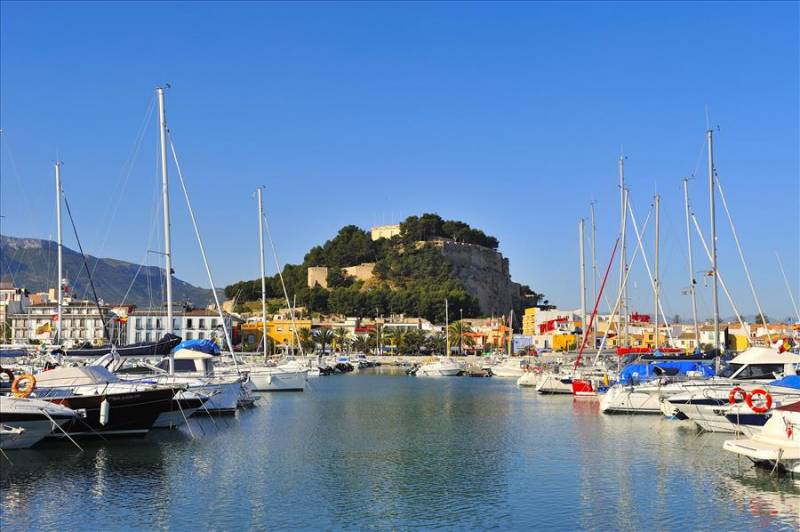
Dénia is the perfect combination of historical charm and trendy modernity entrenched beside the sea. The fascinating history includes a fusion of cultures dating to the first century B.C., of marauding invaders and epic battles right up until the last century, since this city held a key defensive position in the Spanish Mediterranean.
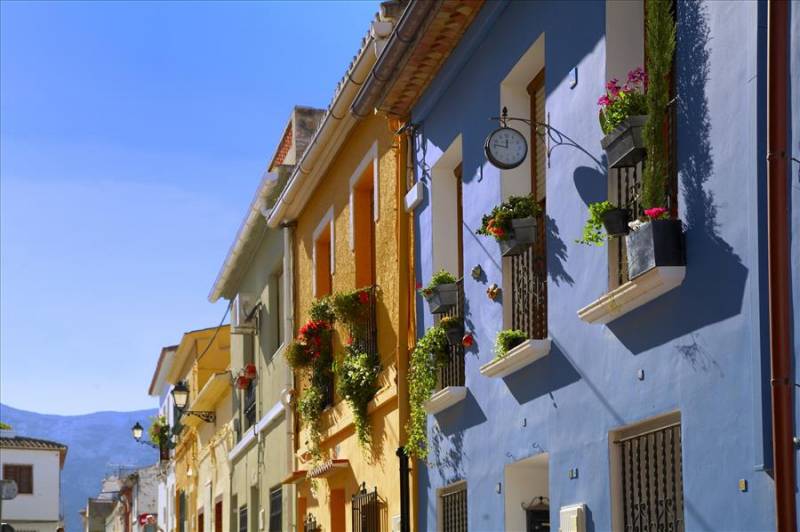
The iconic castle looks down to the ‘old town’ where you’ll find traditional houses converted into exclusive shops or restaurants offering top class cuisine, over to the typical fishermen’s quarter filled with little street cafés and craft shops, across the lengthy seafront promenade to a lively leisure harbour where stylish pubs vie for popularity, and the main ferry port which has regular connections to Ibiza and Formentera (onward sea links to Mallorca and Menorca).
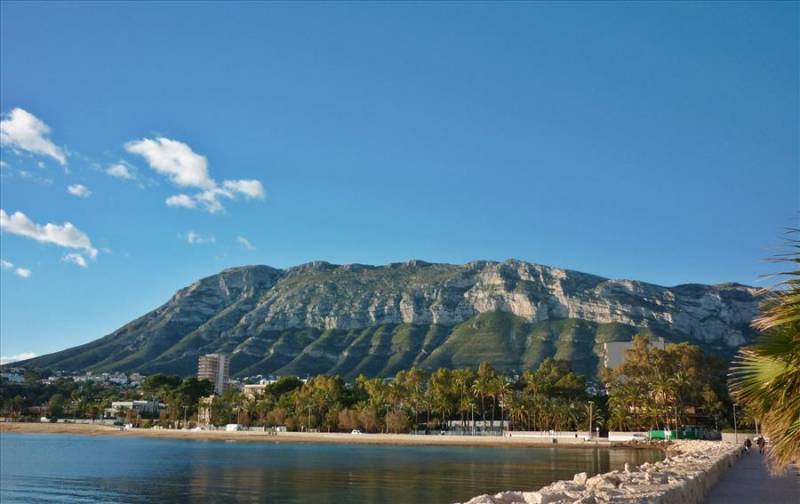
A contrast of golden sand beaches and white pebble coves are ideal for summer relaxation and water sports, while the nearby Montgó Natural Park is a wonderful place to walk amongst mountainous landscape in cooler weather.
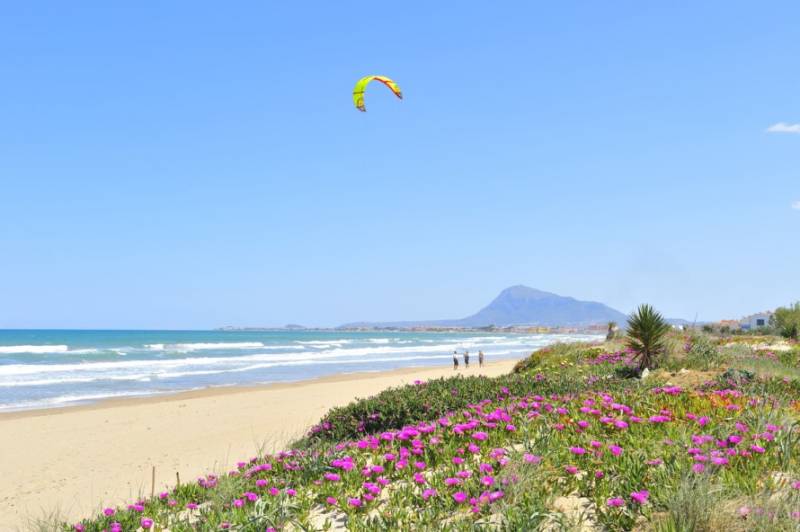
Les Marines is the immense stretch of open sandy beach and dunes bordering the coastline north towards Oliva (just inside Valencia Province) which never gets crowded… popular with everyone from families to kite-surfers, there are camping sites in the vicinity and beach clubs where the ambience is magical as the summer sun goes down.
In contrast, Dénia’s southern Les Rotes section is the place to find secluded rocky coves.
XÀBIA (Jávea) – 25 kms coast
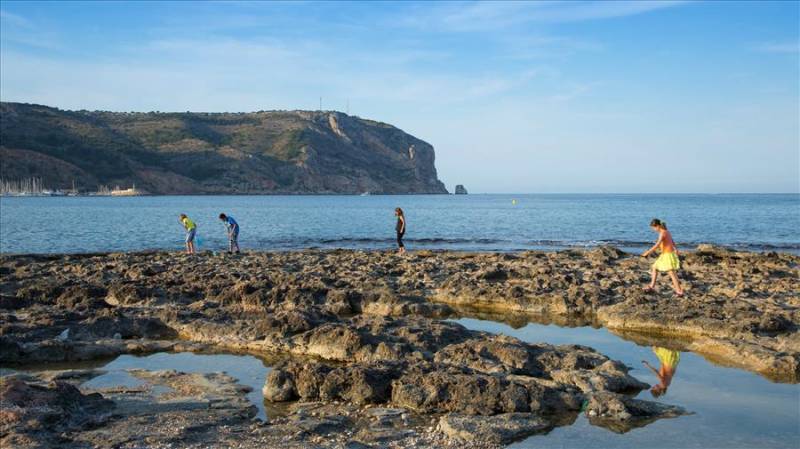
Xàbia lies south of Dénia, in a fabulous location between two capes: Cabo de San Antonio in Montgó Natural Park and Cabo de la Nao, the most easterly point in Alicante Province. La Grava as the name suggests is the natural gravelly flats that edge the seashore just past the fishing harbour, El Arenal is the long central sandy beach fringed by palms, and Cala Granadella is a large secluded bay tucked under steep hills on the drive out of town.
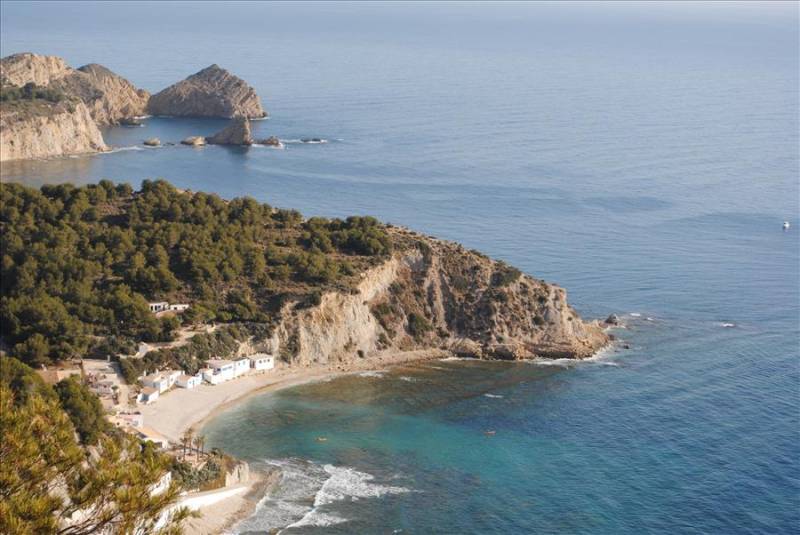
Limestone beaches and rocky coves which are great for snorkelling, the leisure harbour by the old town, and two promenades with a great choice of seafront restaurants are just some of the attractions.
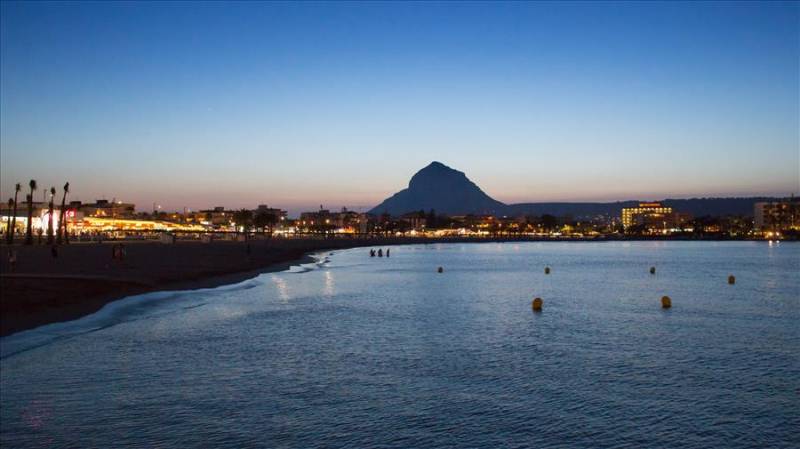
Drive up to the headland lighthouses to see the panoramic views, to Ibiza on a clear day, or walk up if you’re feeling fit to the landmark windmills which overlook the old town and to shady picnic sites among the pinewoods.
BENITATXELL – 2 kms coast
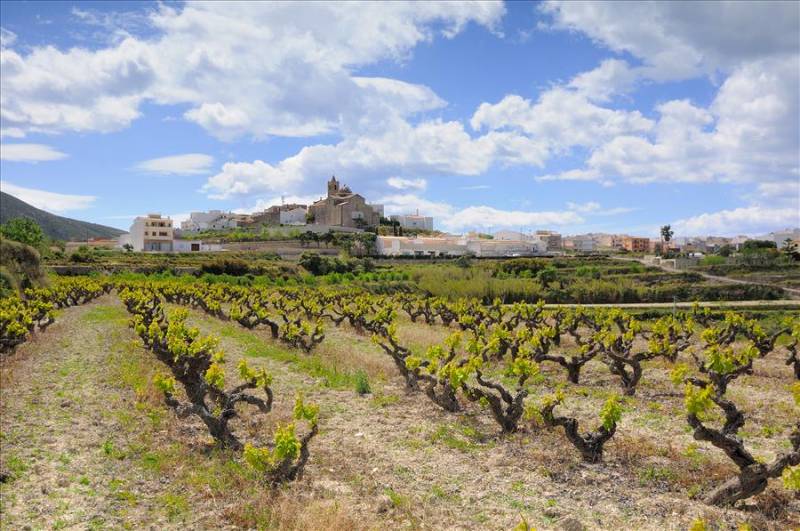
Poble Nou de Benitatxell is a traditional Spanish village perched on a hilltop, the old church spire piercing the sky, looking down on almond groves and vineyards towards the coast where the waves flow into rock coves secreted below the steep cliffs which line the shore – Cala Llebeig and Cala Testos.
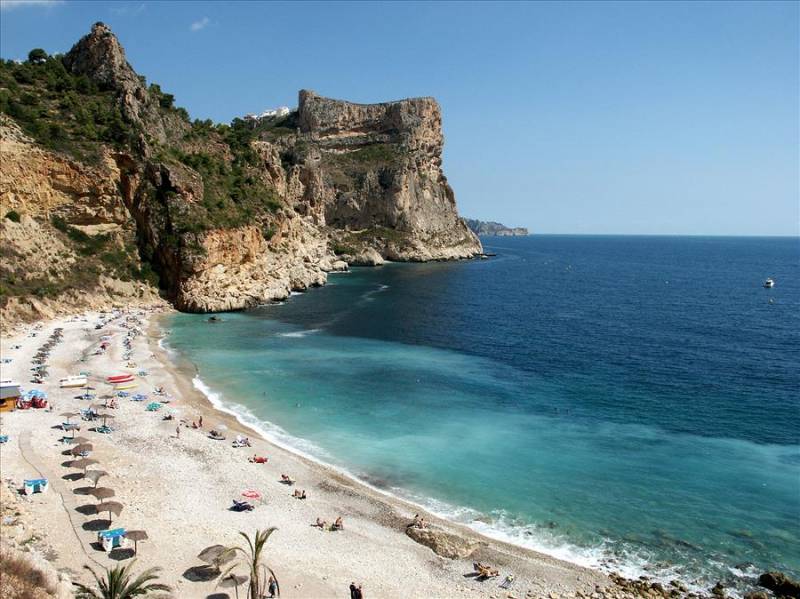
Cova dels Arcs is the local landmark, two limestone arches which have been sculpted by the sea over the centuries near the entrance to an underground river in Moraig Cove (these galleries can only be accessed by specialist cave divers).
TEULADA-MORAIRA – 8 kms coast
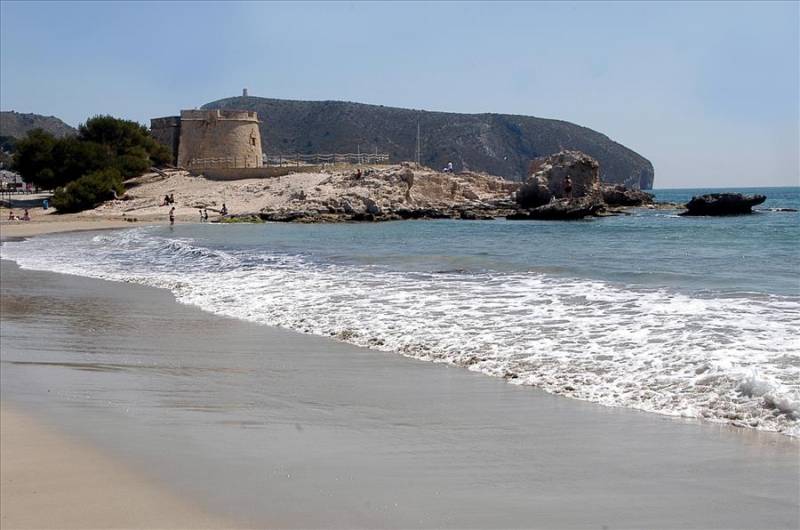
The medieval town of Teulada sits inland on the hill, history evident in the quiet streets and plazas, Gothic, Renaissance and Baroque detail gracing stately mansions and church façades. Visitors, however, rarely see this monumental heritage as they head straight for the beaches…
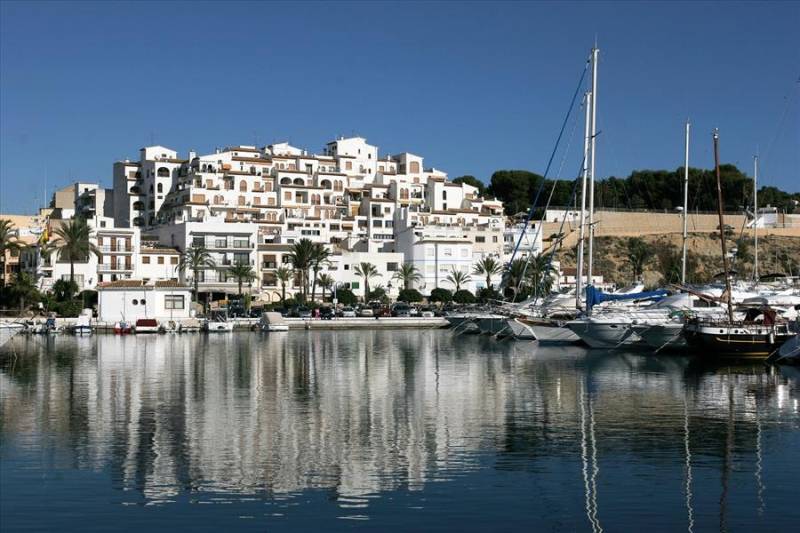
Moraira is an exclusive resort with a smart marina and promenade featuring a small defensive castle. A favourite with yachters and the well-to-do, beachgoers love the sheltered sands and rocky coves lapped by clear seawaters in a delicious scene which seems a million miles away from mass tourism. It’s the perfect place for outdoor dining, on the terrace of a fine restaurant with a glass of excellent Spanish wine!

L’Ampolla is the name of Moraira’s central beach, a wonderfully natural environment with a little stream trickling across the fine sands and marshland with wild ducks gently framing it from behind. Over the headland you’ll find El Portet, a smaller sandy bay fringed by eateries where you can relax beside the sea.
BENISSA – 4 kms coast
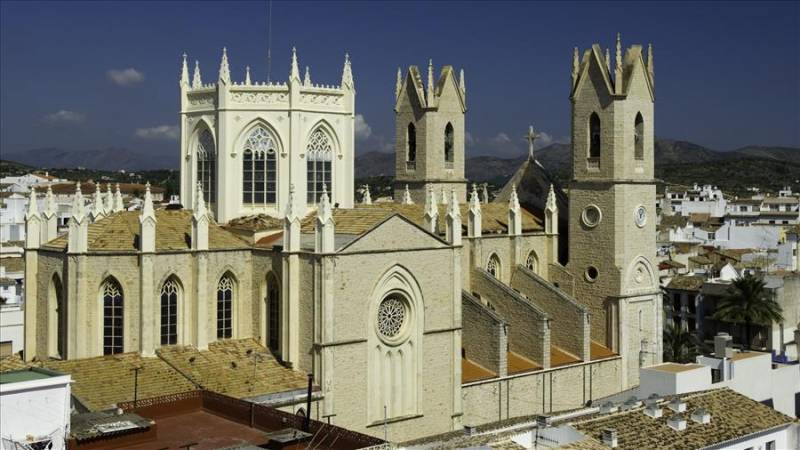
Benissa straddles the N332 main road that runs straight down the Costa Blanca. Who hasn’t seen the sensational ‘Cathedral’ as they drive past? Stop for an hour or two, and delve into the historical backstreets of this interesting town to discover a wealth of practically unknown medieval wonders which include Franciscan convents and monasteries!
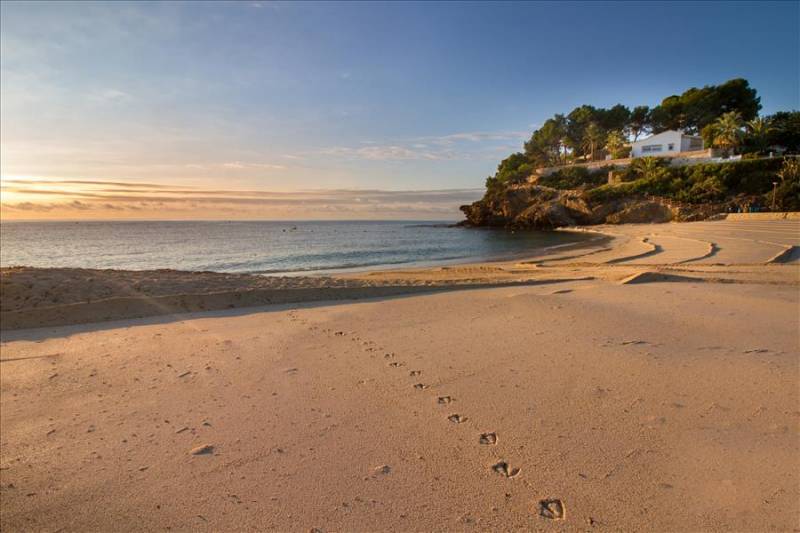
Benissa Coast is a short drive away, a succession of small beaches, sheltered coves and shady picnic areas accessed from the scenic coastal road that winds around the rugged shore. La Fustera is a picturesque small sandy bay and possibly the most popular.
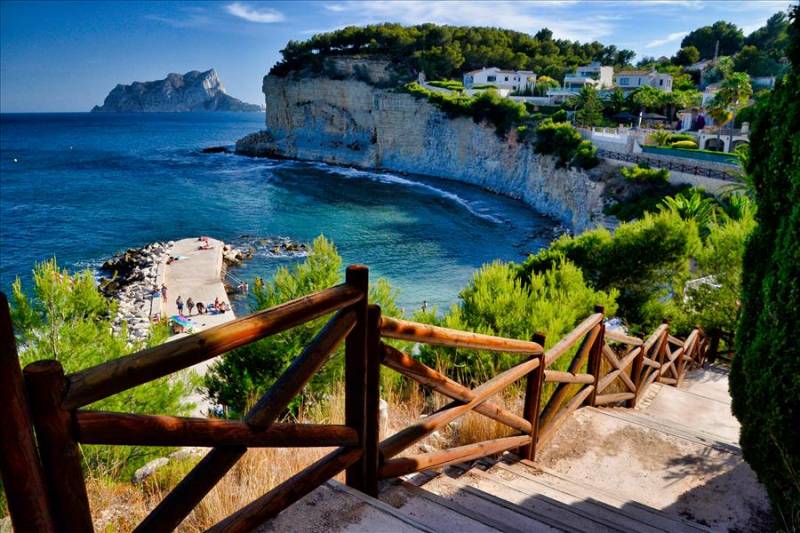
A pathway along the cliff top connects the string of shingle ‘covas’ and limestone platforms, or you can enjoying walking and paddling from one to the other. Don’t forget your water shoes! Finally you’ll arrive at Les Bassettes port, a curious little harbour with a diving school, sea pools by the only restaurant, and the most incredible views of Calpe Rock.
CALPE – 11 kms coast
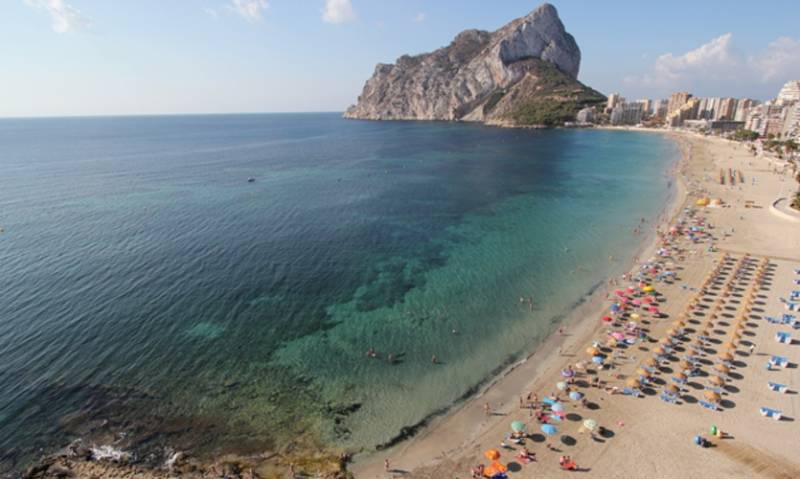
Calpe is fabulous for family holidays. A busy resort in the summertime yes, but definitely not a partying town… The main beaches Arenal-Bols and La Fossa are wide and long, fine golden sands lead down to the habitually calm sea where pedalos and kayaks are waiting to be pushed out.
There are innumerable places to eat and drink along both seafronts, most of them pocket friendly. Enjoy reasonably priced seafood menus at the quayside restaurants too or watch early evening auctions as the trawlers come into port and buy freshly caught local fish!
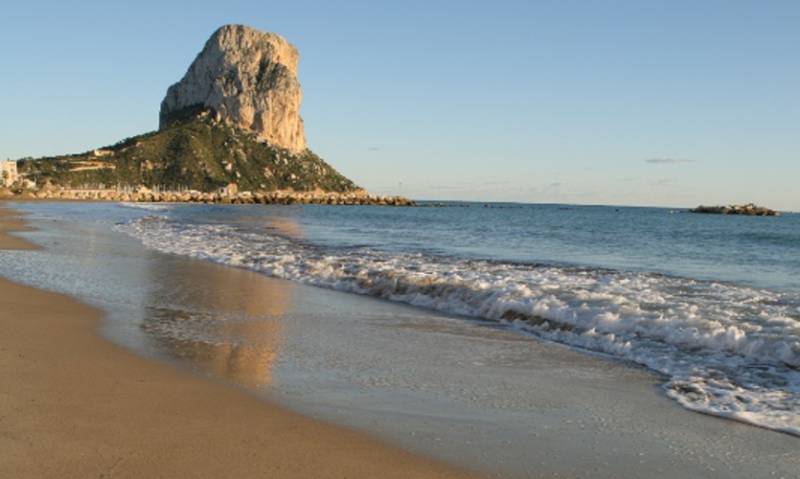
Peñon de Ifach is the iconic ‘Calpe Rock’ which totally separates the two beach areas, a protected nature reserve with a challenging path to the top (the sheer side facing the ocean is used for rock climbing). Roman ruins in the sea and a salt lake with flamingos are other unique attractions of this pleasant seaside town; diving, sailing and fishing just some of the water sport activities.
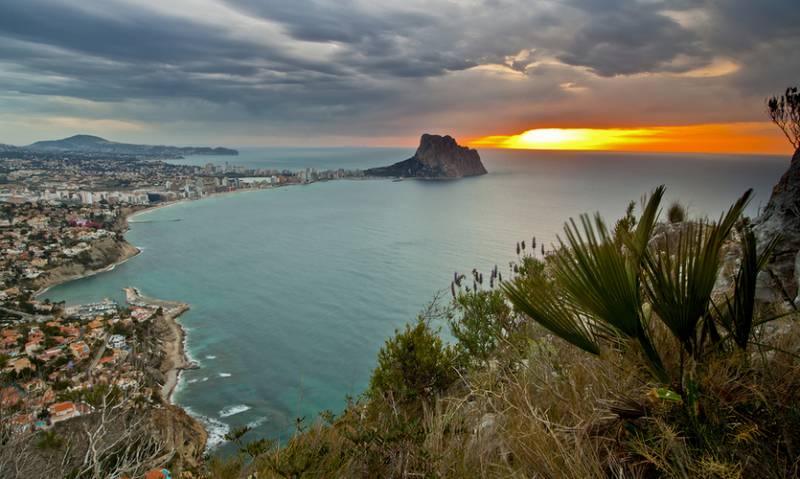
A sprinkling of modern hotels -some offering packages for cyclists as this is a good base for inland touring- plus holiday apartments are the main accommodations. Several coves and Playa Blanca harbour on the outskirts of town are the lesser-known beaches.
MARINA BAJA Area (Marina Baix)
ALTEA – 7 kms coast
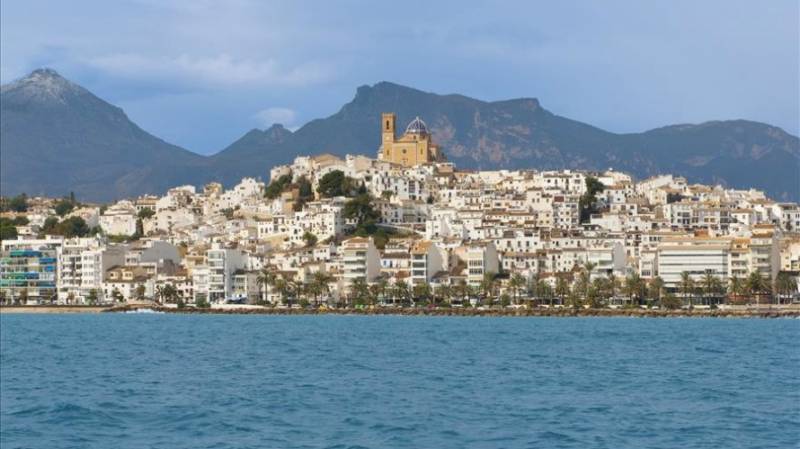
Altea can be seen from afar, the whitewashed village houses sprawling up the hillside topped by a blue-domed church, so picturesque that it’s been named as the prettiest town in Spain and is possibly the most beautiful in the entire Mediterranean. Popular with artists and glamorously bohemian, craft fairs and traditional festivities are held in the summertime –the annual August firework display in the sea off L’Olla beach is world famous!
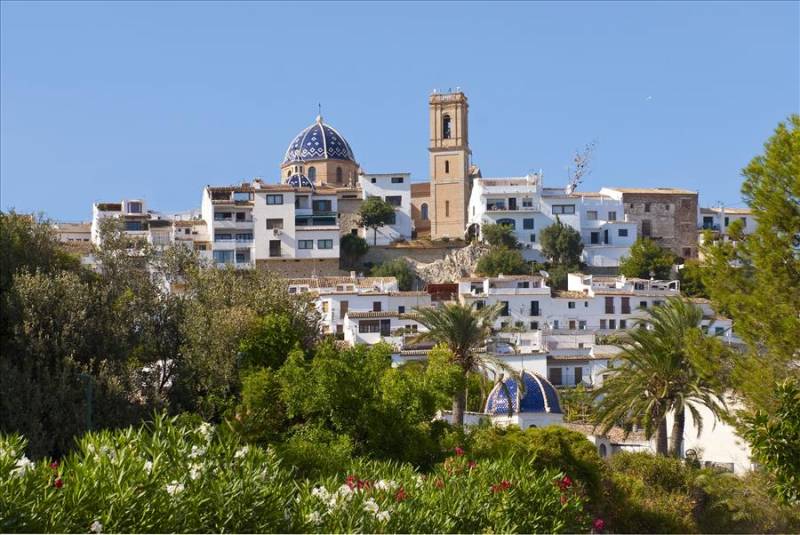
Altea is a unique resort with only a few low rise hotels, the laidback year-round atmosphere coming essentially from the local families whose roots go way back in time, expats from northern Europe who live in outlying urbanizations, incognito Spanish celebrities with holiday homes in the hills, and people from nearby towns enjoying the innumerable seafront restaurants and trendy old town pubs or pizzerias.
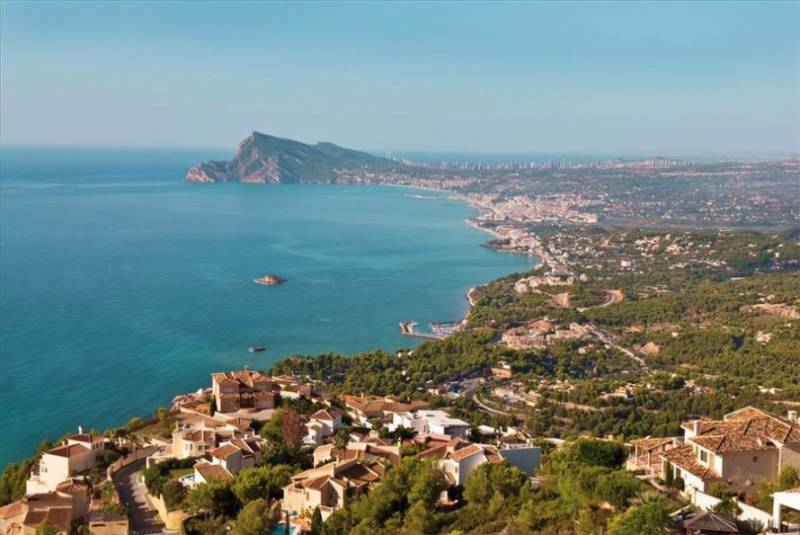
Three main harbours filled with leisure craft are a sailor’s dream –the exclusive Campomanes, secluded Porto Senso, and Altea fishing port marina. Altea’s white pebbly beaches make the Mediterranean seem bluer than ever! The level waterfront promenade swings around towards El Albir at the far end of the bay making a leisurely stroll or cycle ride.
The whole scenic setting is backed by mountains which shield a valley of orchards behind the old town and is watched over by the ruins of an ancient fort high up on Sierra Bernia ridge.
EL ALBIR – 4 kms coast
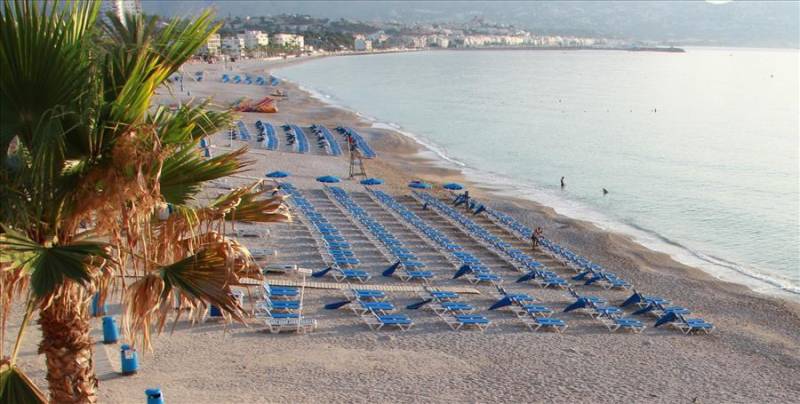
El Albir is a peaceful all-year-round cosmopolitan seaside resort favoured by British, Dutch and Scandinavian residents. A long pebble beach with some sand is bordered by a flat seafront promenade which reaches around the Bay of Altea, the most perfect place to see the sunrise over the Mediterranean Sea.
A host of international restaurants and cafés, and a scenic coastal walk to the lighthouse are the overall attractions (scramble down to see the old ochre mine, or to one of the rocky coves for rod fishing). A more strenuous track leads up to the top of Sierra Helada where there are panoramic views and the start of an arduous 8 km hiking trail over to Benidorm.
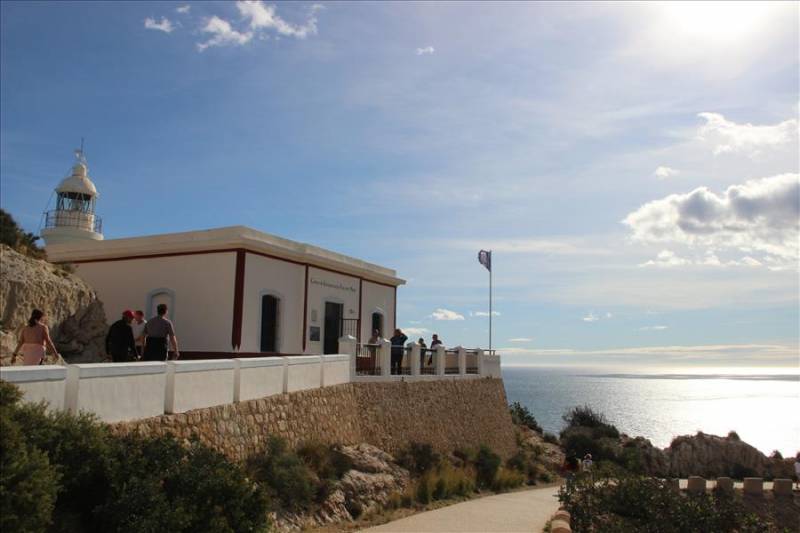
A handful of low storey hotels -including the ultra exclusive Sha Wellness where a Russian president and top pop stars are said to have stayed- various holiday apartments and a new camping complex, are the only places to stay unless you arrive on one of the luxury yachts that occasionally anchor off-shore!
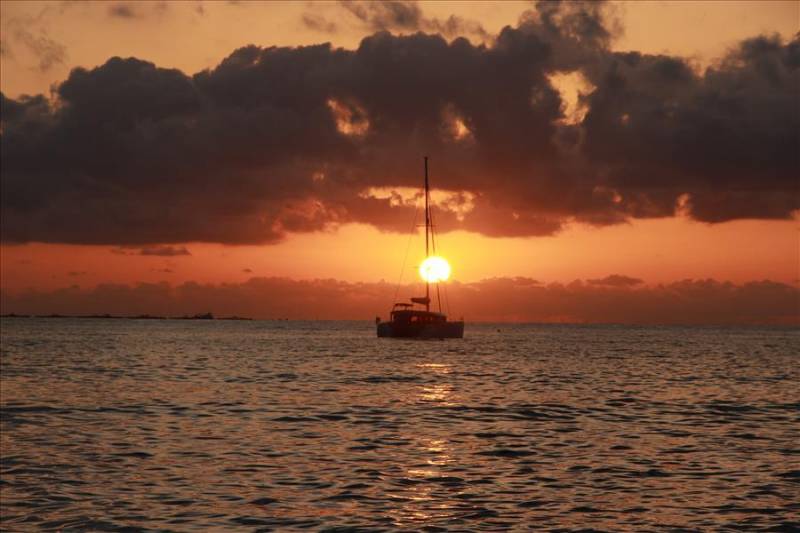
El Albir is a good base if you want to explore Alicante province, particularly the northern and central Costa Blanca, as you can day trip everywhere by car and comfortably visit a different beach each day! El Albir pertains to l’Alfàs del Pi, a pleasant small town with a fascinating history a short drive inland.
BENIDORM – 10 kms coast
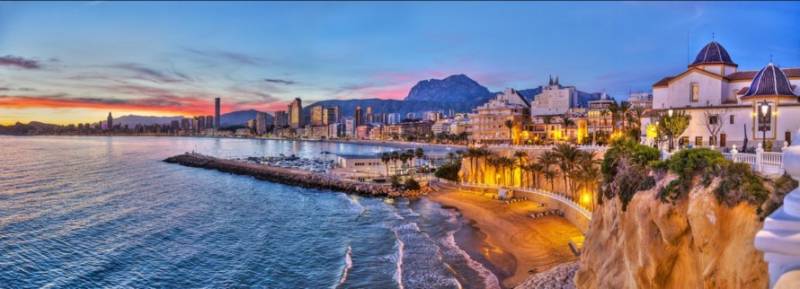
Benidorm is Spain’s top resort and conveniently located on the Costa Blanca some 50 km to the north of Alicante/Elche airport. Unmistakable with its modern high-rise skyline, Benidorm is one of the most important tourist destinations in the entire Mediterranean and is famous throughout Europe for its two immaculate wide sandy bays, innumerable restaurants, markets and lively nightlife.
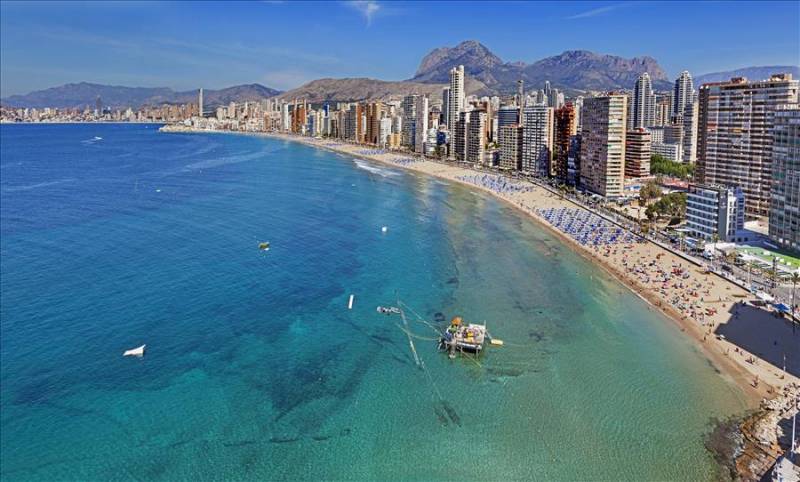
Benidorm is fun and sun, an international scenario where the Spanish have been holidaying since the 1950s! Hot summers, pleasant spring and autumn weather, and mild winters means it’s busy here all year long. There are hundreds of quality hotels and holiday apartment rentals, the vast majority with swimming pools, and within stepping distance of the beaches and all the action.
There are literally thousands of restaurants, cafeterias and pubs…you are spoilt for choice. A favourite holiday destination for both the Spanish and British, a host of other nationalities mainly from Europe love it here too.
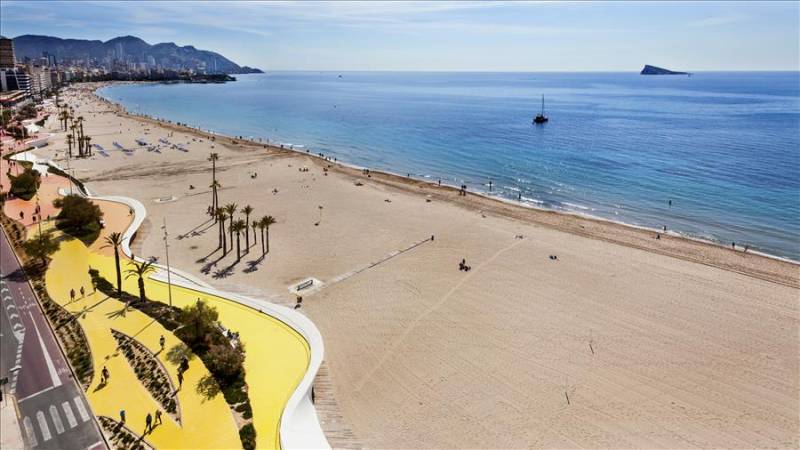
Water parks, theme parks, nature parks are top attractions, and numerous water sports an option… boat trips will take you out to Benidorm Island (a sun-baked nature and marine reserve) or out of the bay and along the coast to other resorts. There’s a golf course and themed hotels, including the elite Asia Gardens, on the outskirts towards Terra Mitíca.
The nightlife is continuous with loads of entertainment and live music venues, for every age group and inclination. Benidorm Palace is the glamorous international nightclub show which only competes with Paris! And we’ve not even mentioned the frequent fiestas, musical festivals or street parades!
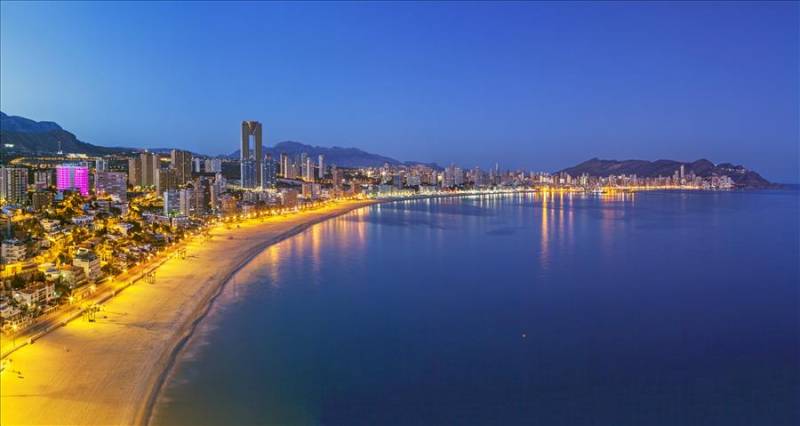
So why is Benidorm so very popular? Apart from the gorgeous Levante and Poniente beaches and the fact that it’s warmer than most places in Europe during winter, the hotels’ quality price ratio is the best I’ve ever seen in the world, in other words strict hygiene and safety measures, excellent comfortable installations, professional staff, often inclusive food and drink, and in-house entertainers, all at very affordable or, if it’s an offer, almost giveaway prices.
Up until now, it’s been extremely cheap and easy to fly to Alicante airport which has low cost flights from many Spanish and European cities. Road and rail connections are good too.
FINESTRAT – 2 kms coast
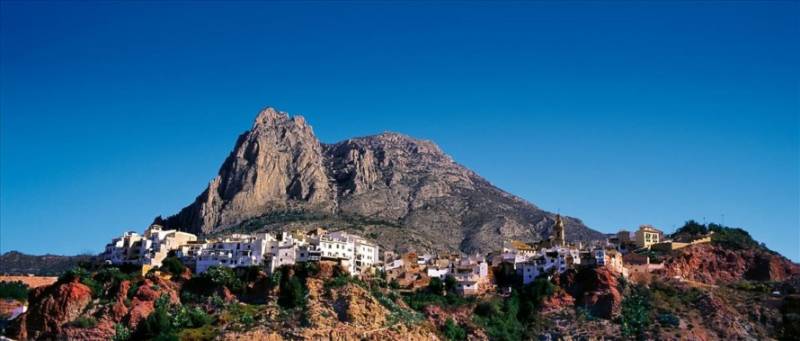
Finestrat is a village at the foot of the iconic Puig Campana, the mountain peak which can be seen from Benidorm. Approach from the coast and the first thing you’ll notice are the ‘hanging houses’. The old town has remained remarkably untouched over the centuries, townhouses renovated and maintained in keeping with the original premises fronting the quiet narrow streets which lead up to a church and gardens where the panoramic vista is spectacular.
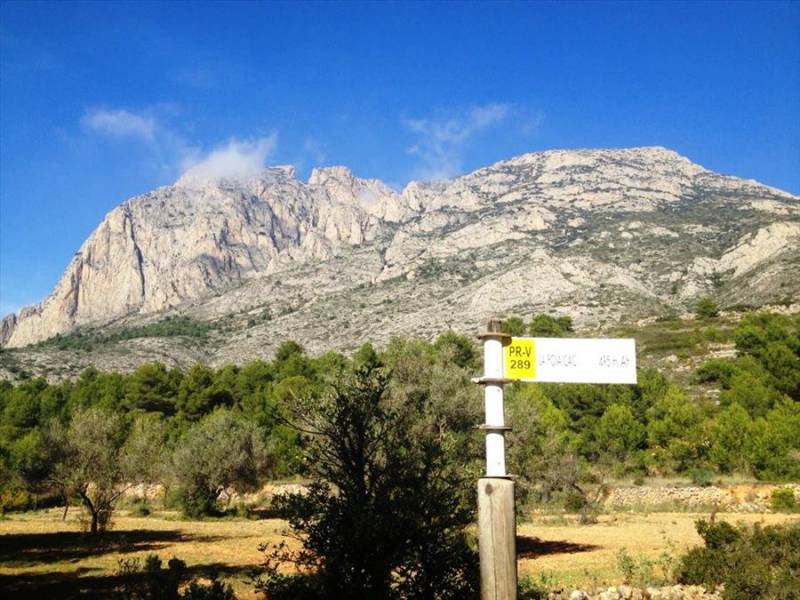
A series of inland walking routes trail through the countryside and across mountainous ridges, passing isolated homesteads and eventually reach neighbouring villages. The hike to Puig Campana peak is the most challenging but a memorable feat – the exhilarating views over Benidorm and great part of the region are absolutely awesome at dawn or sunset (bring warm clothes, a torch and a comfy ground mat if you’re staying overnight).
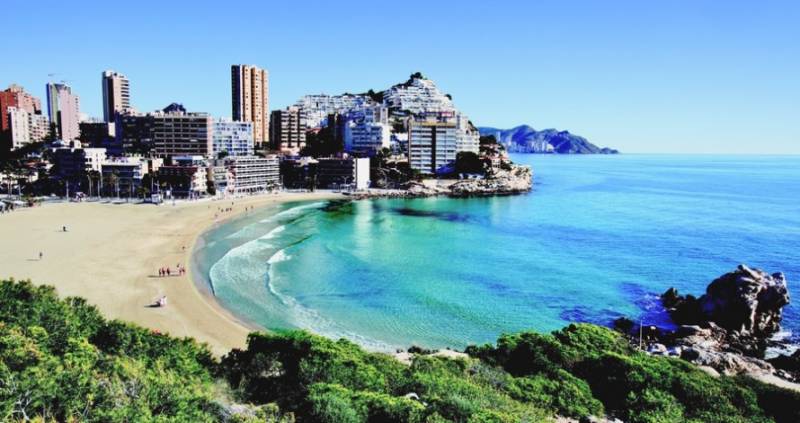
La Cala de Finestrat is a sandy bay just south of Benidorm which pertains to Finestrat municipality. Over recent years this area has been developed out of recognition by mega apartment complexes mainly on the adjoining hillside (La Cala Villajoyosa).
It’s a lovely sheltered bay and safe for bathing making the perfect holiday for families with children, however, as you can imagine this resort really has become busy. There are plenty of reasonably priced eateries here and the main shopping centres of the whole Marina Baja are only 15 minutes walk away (frequent bus service, and also into Benidorm).
VILLAJOYOSA – 15 kms coast
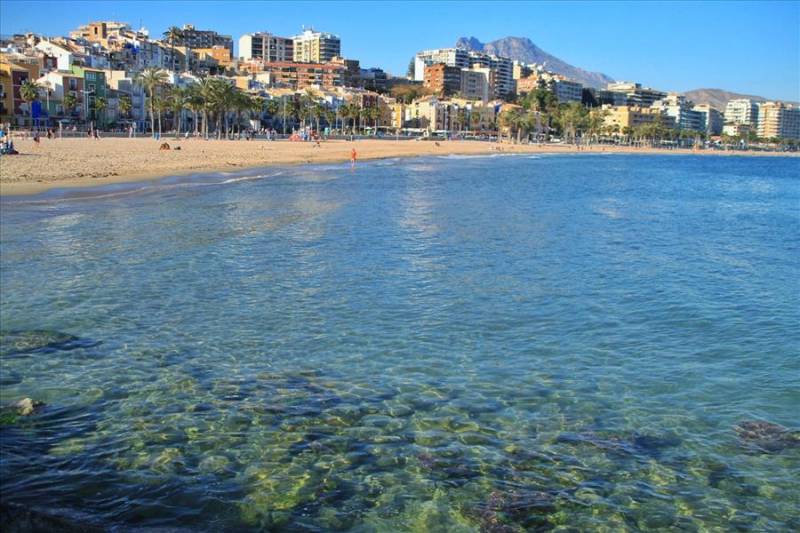
Villajoyosa looks like the Caribbean! This brightly coloured fishing village, virtually undiscovered by tourists, is a total contrast to Benidorm which is only a 10 minute drive away. The wonderful main beach is sandy too, with a wide promenade lined with a selection of restaurants and cafeterias.
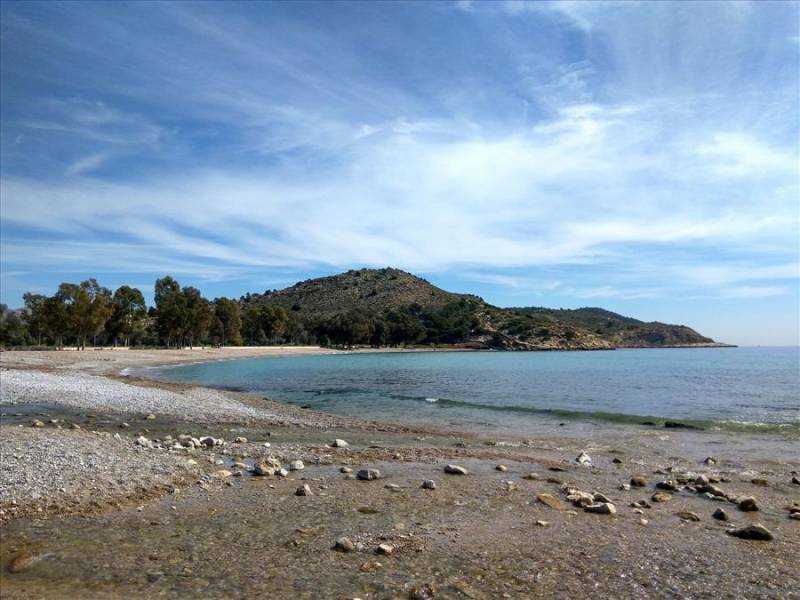
There are a number of smaller pebble and sandy bays -some with summer ‘chiringuito’ beach cafés- in both directions along a coast which is otherwise bordered by cliffs. This is a more traditional town with mainly local Spanish residents, a fascinating ancient history, and it’s very own chocolate factory!
The cuisine includes seafood dishes and there are lots of original ‘tapa’ bars by the indoor food market, for example, where you can enjoy tasty aperitifs away from the tourist scene.
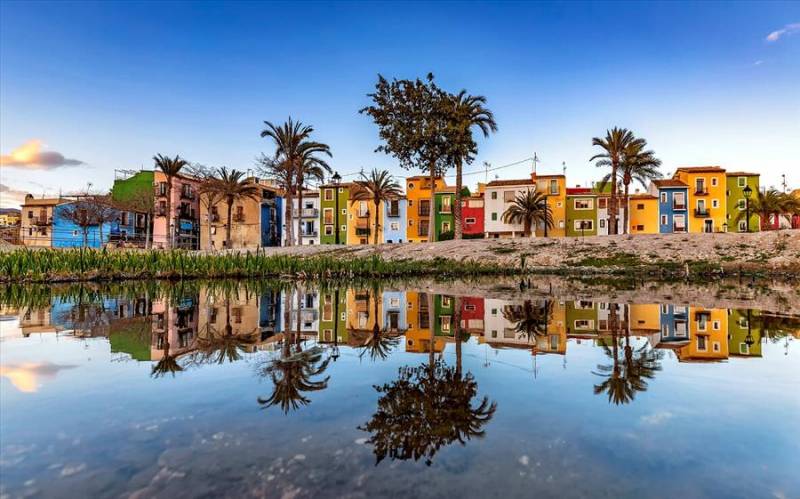
‘La Vila Joisosa’ has been here since Iberian times and was an important Roman settlement with a fish salting industry. A series of defensive towers are witness to medieval history of pirate attacks and Moorish invasion. La Vila is famed for its historical Moors and Christians fiestas in July with ornately dressed street parades and a mock sea battle beach at dawn on the last day. This shouldn’t be missed. If you don’t want to stay up all night, get to the main beach just before dawn as the sun comes up.
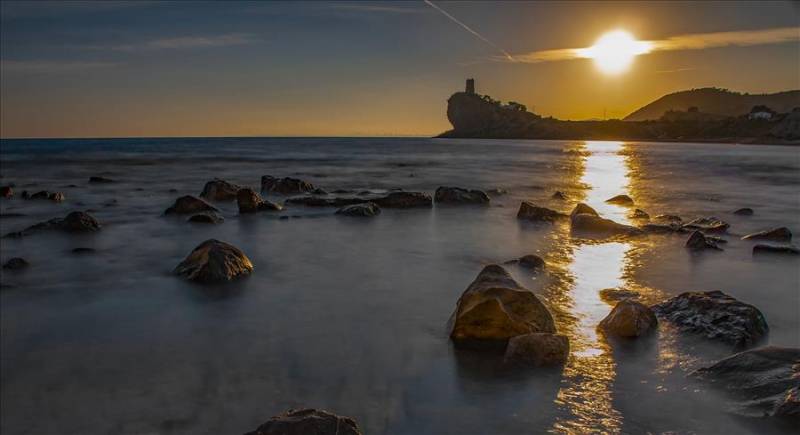
Once again very few hotels and only a sprinkling of holiday apartments means it’s worth booking accommodation in advance as this central resort makes a wonderful base for exploring the whole of Alicante Province, simply driving along the coastal region and inland into the mountains.
ALICANTE Area (L’Alacantí)
EL CAMPELLO – 23 kms coast
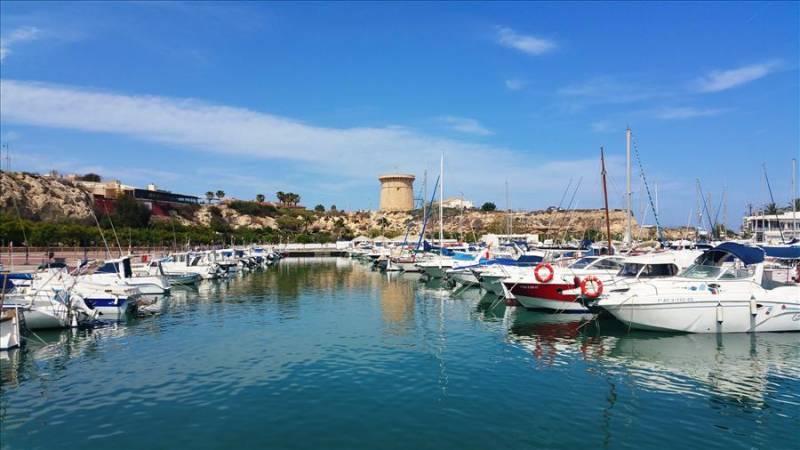
El Campello’s northern stretch of coastline is a landscape of secluded coves, some partly urbanised, others wild and natural, easily accessed by car, bus or tram.
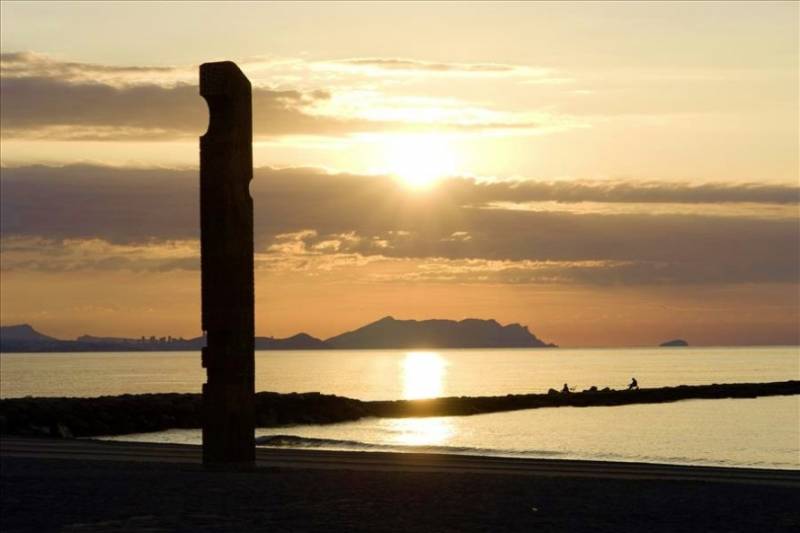
In contrast, ‘Carrer de la Mar’ is a broad sandy beach fronting the main part of town with an original ‘tribute to the fisherman’ monolith in the sea. The original fishermen’s dwellings beside the seafront have long ago been refurbished as restaurants -the majority specializing in seafood rice dishes- which are popular with day trippers from Alicante, the local expat community and holidaymakers.
A pleasant resort with lots of water activities but not the place to flock to if you’re looking for nightlife or an international vibe.
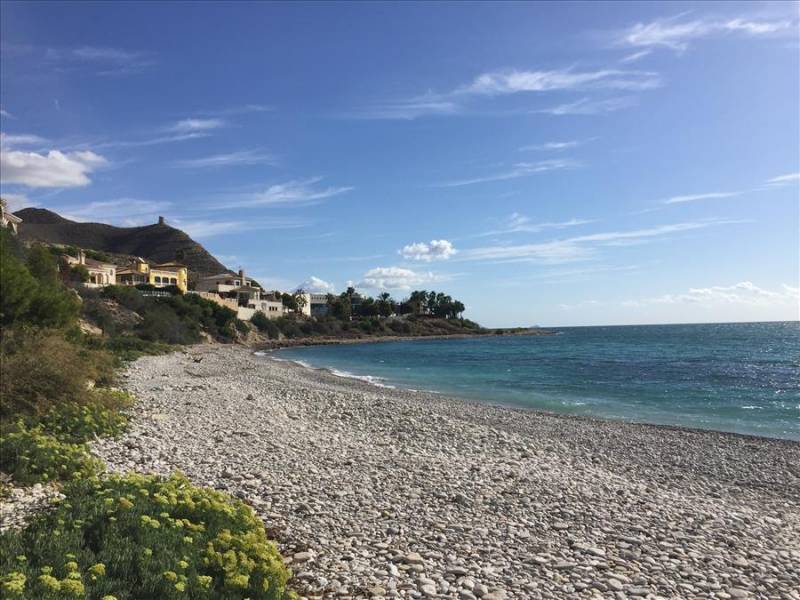
A Roman watchtower marks the northern end of the promenade, just near the yachting marina and nautical club, and there’s a small fishing port where you can watch the fish auction on the quay as the boats return in the evenings!
Kids love paddling and snorkeling in the shallow rock pools formed by the platform which links out to ‘Illeta dels Banyets’ an archaeological site in the sea. Meanwhile, the underwater rock barrier running parallel to Campello coast is perfect for scuba diving.
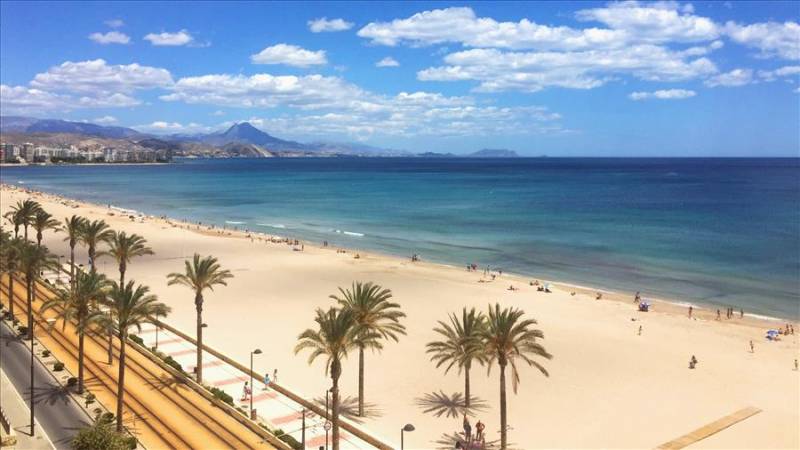
The far southern end of the seafront stops at Punta del Riu, the ‘Dry River’ estuary where the shingle beach is ‘dog friendly’. Muchavista beach is further on around the point and makes up the first part of the incredible San Juan beach, an immense sandy bay which stretches away towards Alicante City.
ALICANTE – 23 kms coast
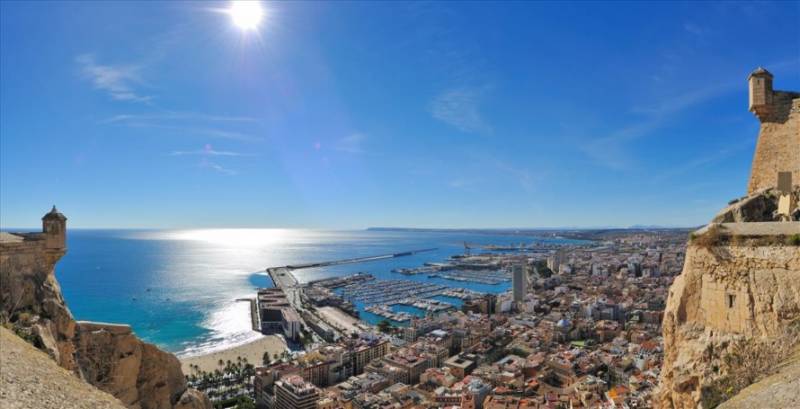
Alicante City, capital of the province and a major port with ferry and cruise liner terminals, has a variety of beaches to choose from, these are just some…
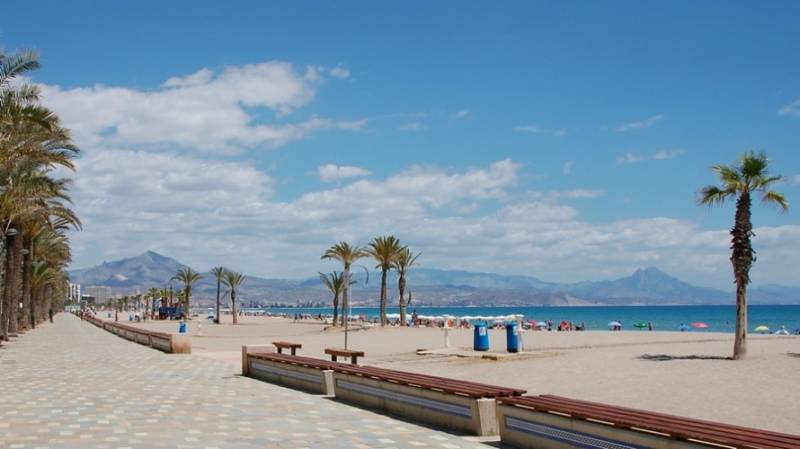
Kilometres of uninterrupted broad open sands run down Alicante’s magical San Juan Beach which is backed by a wide seafront boulevard, the number of holiday apartments, restaurants and pubs increasing towards the southern end. A smart tram line and numerous parking facilities make the area easy to get to.
A bit hectic in the height of the summer although there’s still plenty of space for social distancing, the rest of the year it’s virtually free from tourists. A lighthouse marks the far end of the bay at Cabo de la Huerta; four secluded coves around the capes can be reached on foot. The unmistakable Alicante skyline appears with Santa Barbara Castle as a focal point.
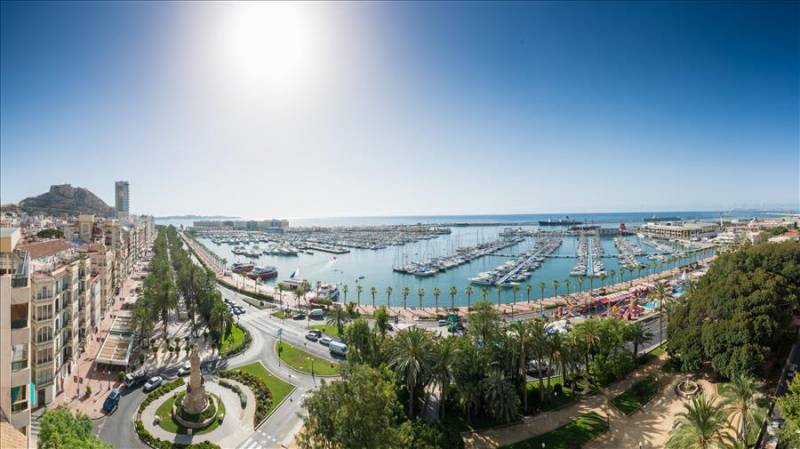
El Postiget is the name of Alicante city’s central beach, once again sandy and child friendly. The busy, tree-lined promenade is complete with alfresco cafeterias and craft stalls. The modern leisure harbour continues from here – the complex includes a casino, seaside restaurants, nightclubs and a shopping mall.
Alicante city centre sprawls back with avenues of classy stores, trendy ‘tapas’ bars and eateries in the walking streets and historic plazas in the heart of the old town. Alicante’s coastline continues in a more natural environment of golden sands and dunes from Saladares beach down to the south.
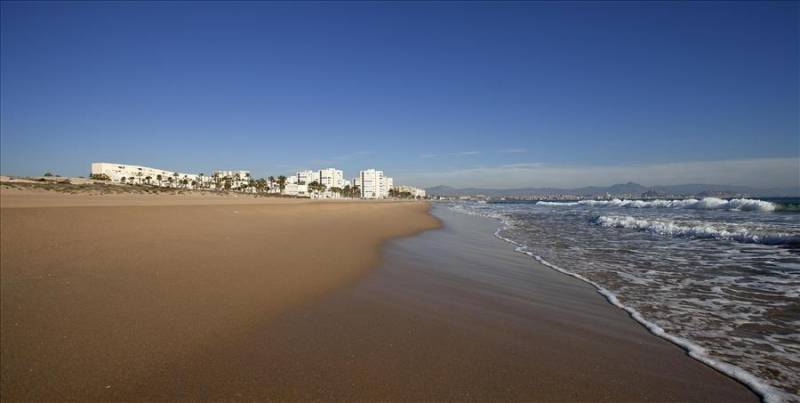
The legendary San Juan fiestas of June summer solstice week take place in Alicante featuring street parades, live bands and DJs on the promenades, beach parties and monumental firework displays coming to a crescendo on June 23rd bonfire night and the following day’s San Juan bank holiday.
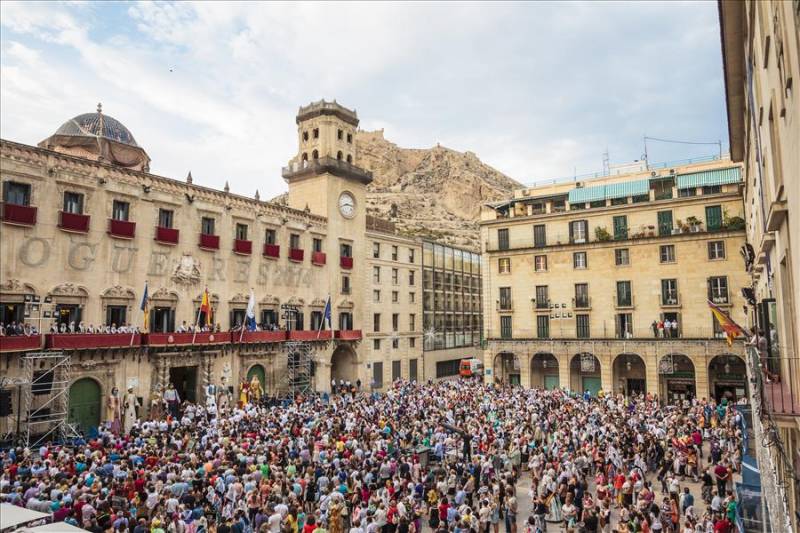
Major transport hubs include Costa Blanca’s Alicante/Elche international airport, the city’s central bus depot, rail terminal and tram station.
Tabarca Island
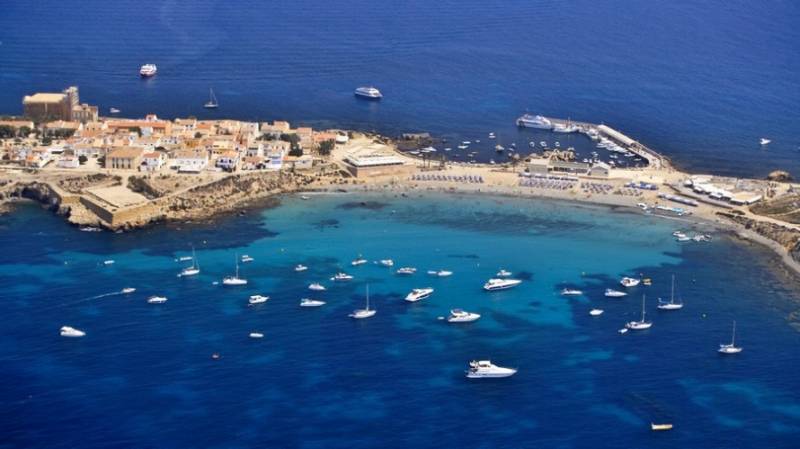
Tabarca Island lies 11 nautical miles from Alicante City. A protected nature and marine reserve which was once ruled by pirates, with a fortified village of cultural interest and a score of great restaurants, it is the only inhabited island on the Costa Blanca.
Come over for the day on a boat from Santa Pola (8 km), Alicante or Benidorm, and there’s plenty of time to explore the whole isle, the fishing harbour and the historical walled Tabarca village itself, a walk around the sun-scorched peninsula to the lighthouse, enjoy awhile on the beach or at one of the little coves, cool off in the sea, then relax over lunch with full sea views.
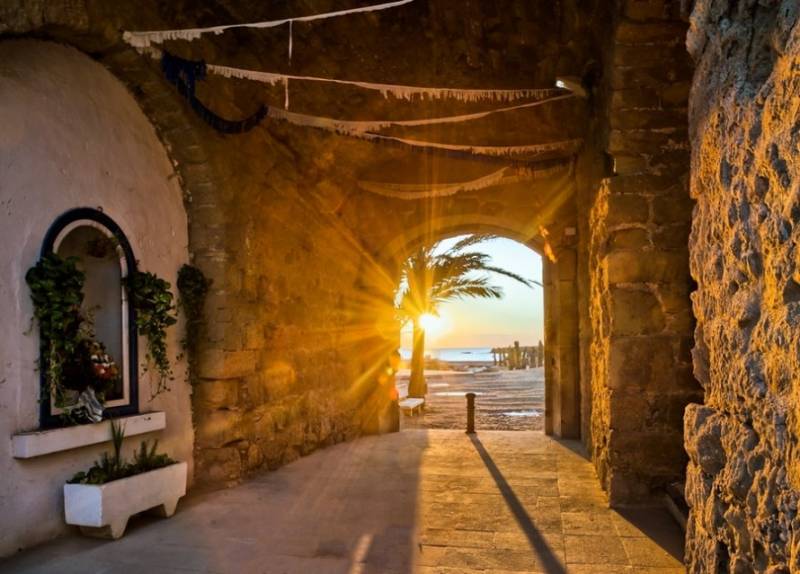
Coming by private yacht is an exciting option, organize your own escapade with a group of friends on a private charter, bring a picnic, a towel and sunscreen+ and just have fun! The diving is great here too but make sure to get the necessary permits in advance.
Southern Costa Blanca – VINALOPÓ BAJA (Baix Vinalopó)
ELCHE – 12 kms coast
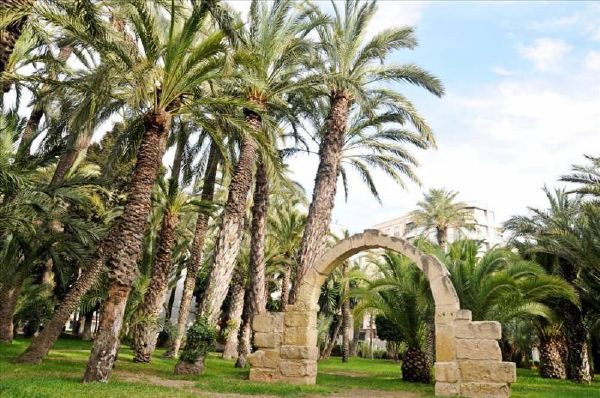
Elche lies 18 km inland from the Mediterranean Sea – the historical city known for its UNESCO World Heritage Site ‘El Palmeral’ palm groves and medieval Easter festivities. The monumental old town is worth a visit particularly the zone around Santa Maria Basilica, and the beautiful public gardens which originally dates to the 17th century.
El Hondo wetlands nature reserve is part of Elche’s lagoon ecosystem and one of the best spots in the province to observe birds. The beaches are located in two distinct sections divided by Santa Pola headland, a separate municipality since 1812.
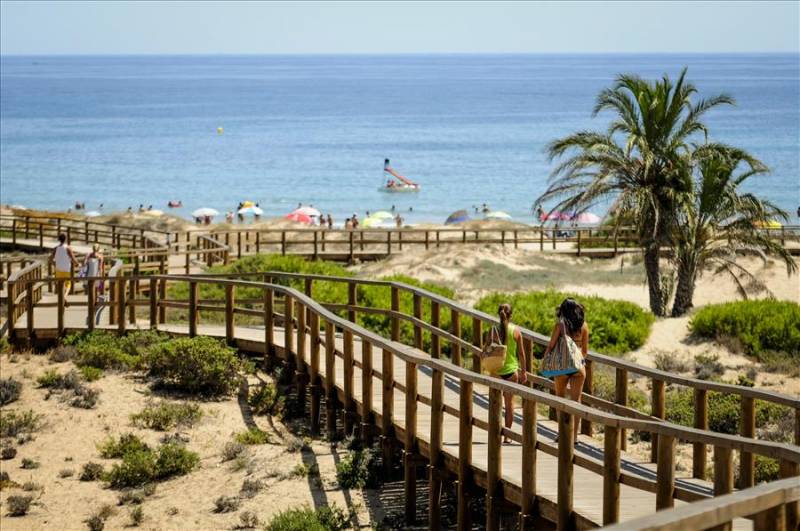
Elche North – from Alicante to Santa Pola Cape.
El Altet beach is a continuation of Alicante Saladares-Urbanova; Las Arenales del Sol roughly translates to sunny sandbanks and perfectly describes this expanse of sands with wooden walkways to protect the natural ecosystem; a ‘new town’ of high rise flats is the urban area quite close to El Altet town and the international airport; meanwhile the never-ending pale sands follow the seashore on to El Carabassí, the naturist section beside the dunes.
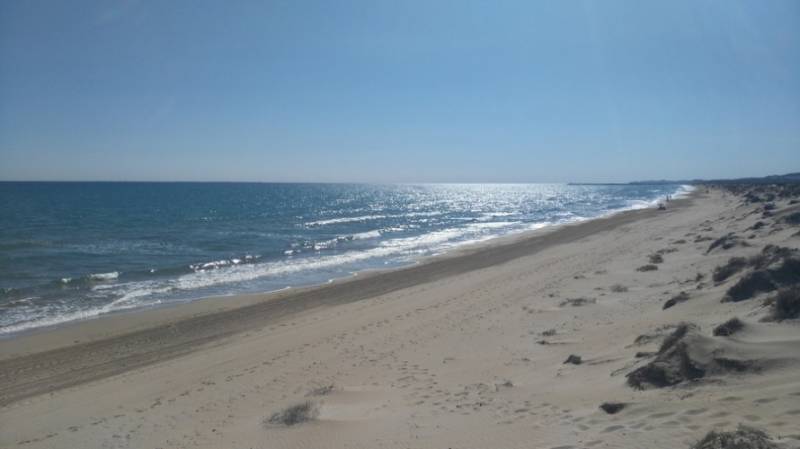
Elche South – Santa Pola Salt Lakes to the River Segura Estuary.
El Pinet dunes and pinewoods extend south for several kilometres from Santa Pola salt flats. A row of old beach houses and a couple of restaurants the only construction; La Marina is the following stretch of golden sands backed by a natural park of protected sand dunes and pine trees (the dunes are sheltered and great for picnics any time of year); Les Pesqueres-El Rebollo is the southern end of this extraordinary coastal strip which makes up one of the most impressive natural beaches in Mediterranean mainland Spain.
SANTA POLA – 15 kms coast
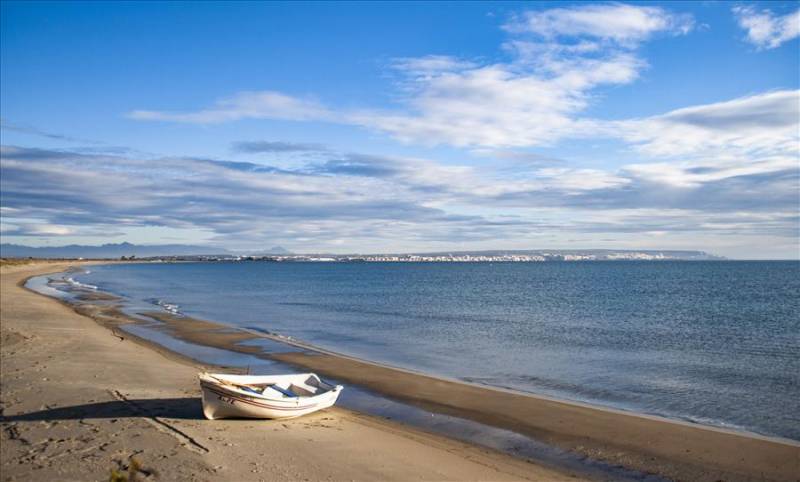
Santa Pola coastline curves around a cape of the same name, the main resort being just south of the lighthouse headland; attractions include a plethora of wide sandy beaches, as well as salt lakes, fishing and leisure harbours (boats to Tabarca Island) and some interesting local historical remains. Known as Portus Illicitanus in Roman times, the castle fortress and iconic watchtowers were erected in the 1500’s.
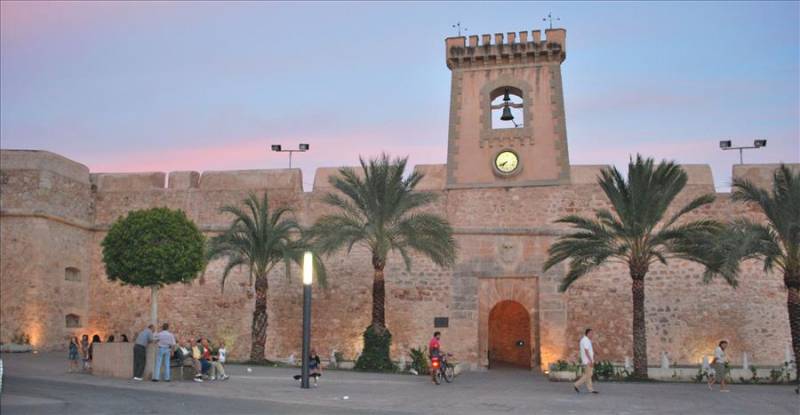
Sun, sea and salt would be an apt slogan! A lovely seaside resort with beaches that everyone will love, children and adults alike, -urban or nature-bound, and others with a delicious balance somewhere in between- and there’s a special one for dogs!
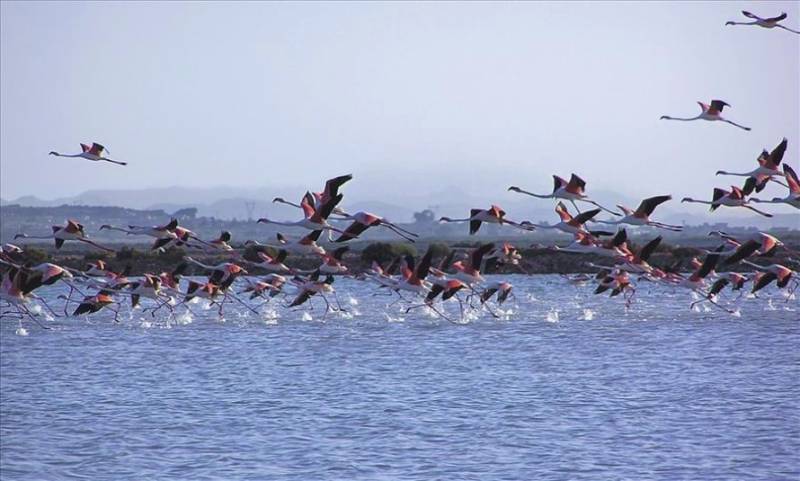
Marching along in quick succession you’ll find secluded coves under Cape Santa Pola (Del Virgen, L’Aljub, Del Cuartel, Bancal de L’Arena), central town beaches with promenades and all the facilities (Varadero, Bernabeu Coves, Llevant), to the great open sands past the harbour which are a favourite for water sports and generally uncrowded (Gran Beach, Lisa Beach), and the endless dunes and pine forests skirting the salt flats lagoons to the Vinalopó River estuary (Tamarit and La Gola beaches).
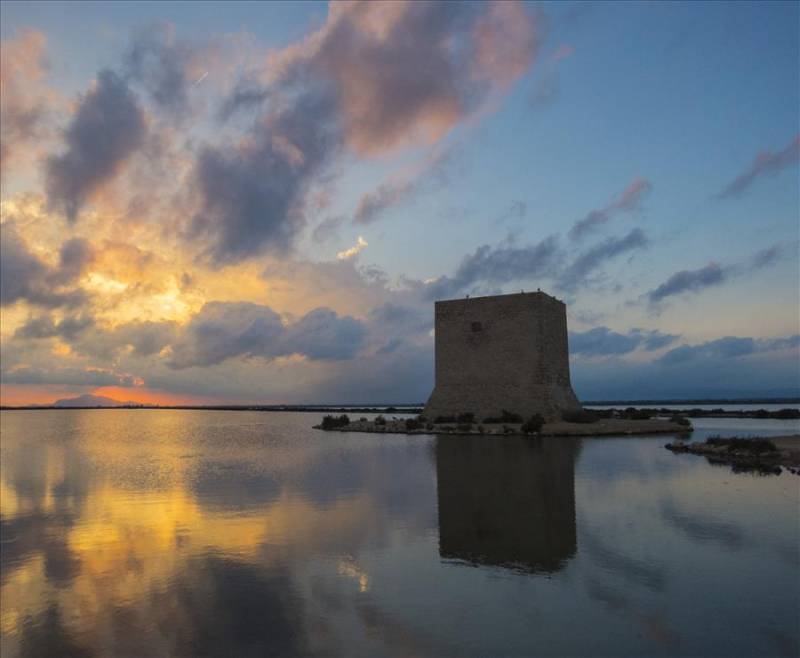
Impossible to miss as you drive along Costa Blanca’s main N332 coastal road, Santa Pola is an extraordinary sight, white salt piled high like pyramids, iridescent pink hue of the salt shallows and migrating flamingos shyly paddling on the far side in peace.
VEGA BAJA Area (Baix Segura)
GUARDAMAR DE SEGURA – 14 kms coast
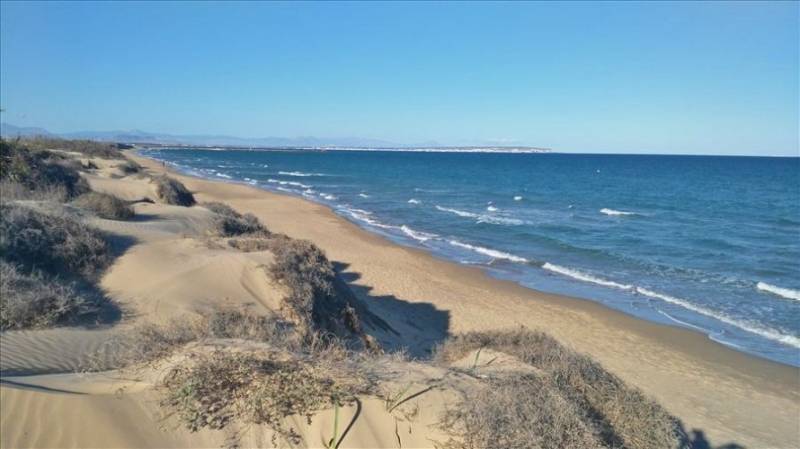
Guardamar is the resort beside the mouth of River Segura. A track leads down the left-hand bank to Els Tossals beach, almost 2 kilometres of natural golden dunes along a beach backed by pinewoods (making up the southern part of the ecologically protected belt of sands which extend down from Santa Pola lagoon).
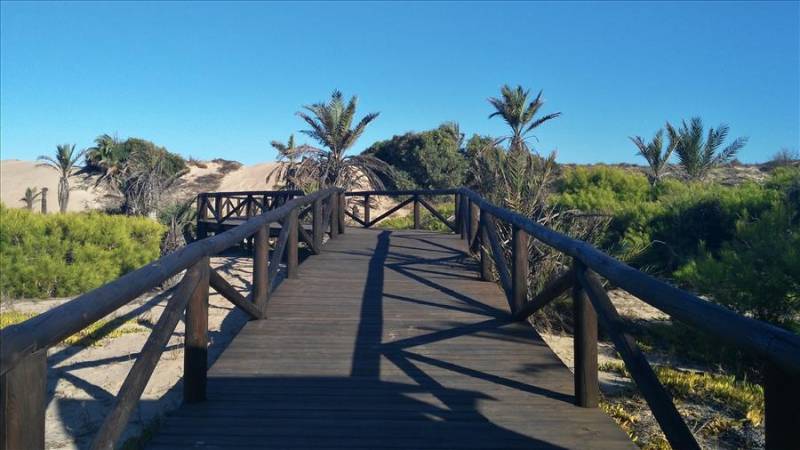
The fabulous sandy beaches continue for 10 kilometres on the other side of the riverbed changing name several times before reaches Torrevieja. Walking from River Segura southwards you’ll start at Els Vivers, a similar stretch of unspoiled sand, past Babilònia beach where there are typical holiday bungalows put up decades ago, before coming to Guardamar’s Centre Beach and the main promenade.
Urban beach facilities continue at La Roqueta where the backdrop of holiday homes lessens, El Montcaio becomes quieter and seamlessly merges into El Camp and Les Ortigues which are once again expanses of pure unmitigated sand dune beach.
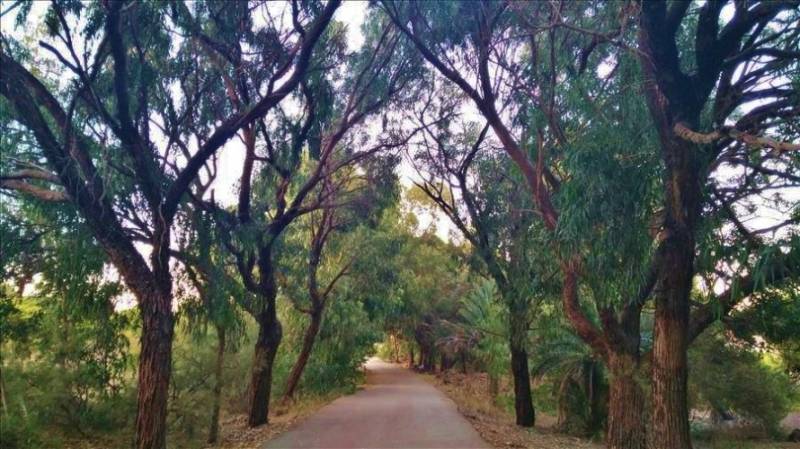
A new marina complex on the right-hand side of the river with leisure craft and all kinds of water sports is a focal point, and is home to the weekday morning daily fish auction where you can buy freshly caught seafood. Walk into Alfonso XIII Park and stroll along the paths through the dune area of reforested pineland which makes up an environmental landscape project begun back in the 19th century.
If you’re looking for some shade or have small children in tow, head towards the town square and into Reina Sofia Park where the water features feel immediately cooling and the ducks in the ponds are an added attraction.
TORREVIEJA – 14 kms coast
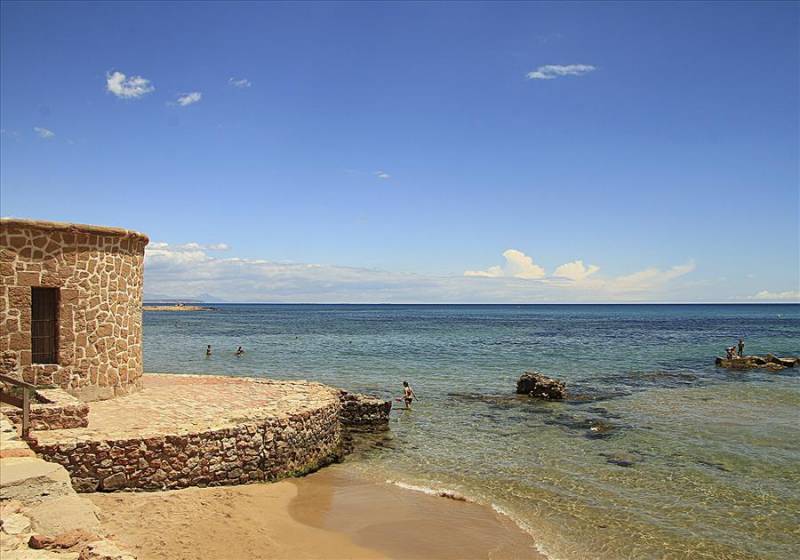
Torrevieja is a lively destination on the southern Costa Blanca, once a traditional salt mining and fishing village it’s grown into an immensely popular tourist resort over the past decades, particularly with the Brits and northern Europeans as well as the Spanish, many of whom have holiday homes here.
This is a cyclist’s dream with a convenient network of bike lanes around town, and almost 50 km of coastal route that goes right down to San Pedro del Pinatar in Murcia Province. Natural attractions include the the Lagoons of La Mata and Torrevieja nature park and a diversity of good beaches.
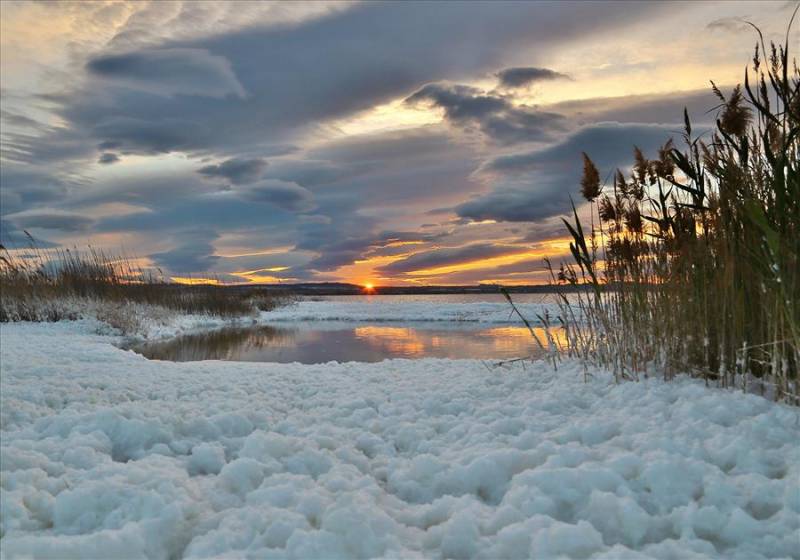
The stunning salt lakes which are often tinged pink are not only picturesque but brimming with wildlife. At Torrevieja Lagoon see the ‘mountains of salt’, then move on to La Mata Lagoon where nature paths lead to lookouts where you can quietly bird watch the flamingos.
Ride a cycle or horse through the woodlands, stop to picnic under the shady trees, and then head down to the seafront.
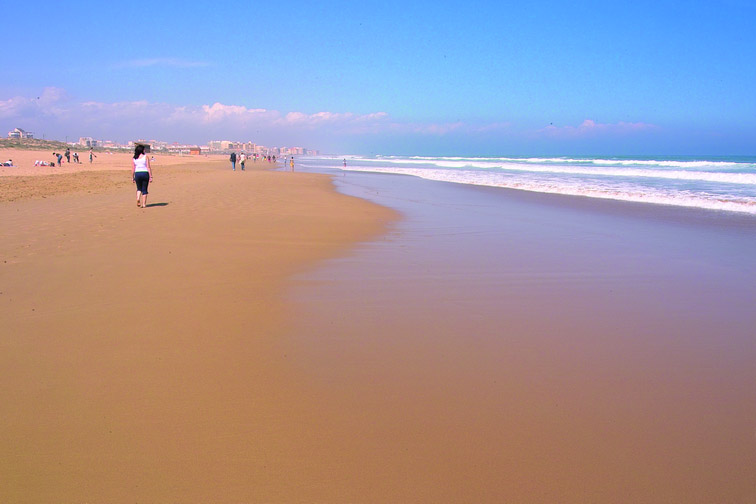
Let’s start at La Mata, Torrevieja’s largest beach, nearly two and a half kilometres of fine sands with a promenade and boardwalk, and all the amenities you need to safely enjoy a day out at the beach. La Mata watchtower sits like a little castle by the water’s edge giving the area its name.
Ideally suited for walking, it’s only 10 minutes on foot to La Mata Lagoon, or take a stroll directly north across the breakwater to Playa Ortigues, right up to Guardamar and beyond. The promenade connects all Torrevieja beaches from La Mata downwards to Los Naufragos.
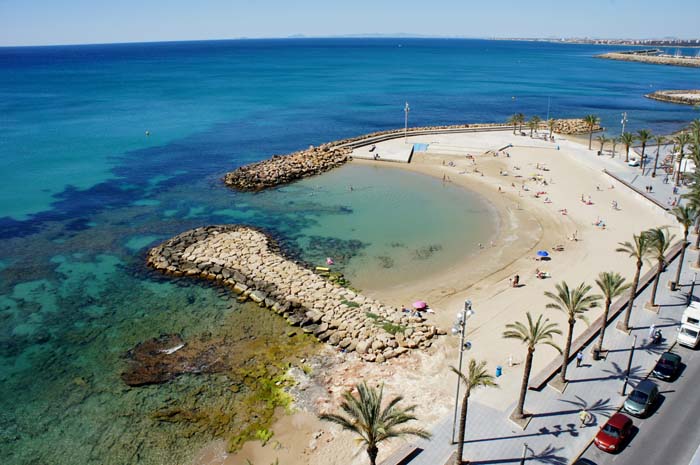
Cabo Cervera and Las Calas are a string of rock coves, great for swimming and snorkeling as the seabed is sparking clear and sand-free. Playa de Los Locos is large and sandy with designated areas for beach games, a seafront promenade with a boardwalk which curves around Palangre point.
El Cura is the popular main beach where there are plenty of seafront cafeterias and the landmark ‘Columns’ Monument to Mediterranean Culture is a beautiful feature. Juan Aparicio Promenade is the section where the rocky coastline has been designed into a series of sheltered sea pools which look just like cute sand basins known as Las Piscinas.
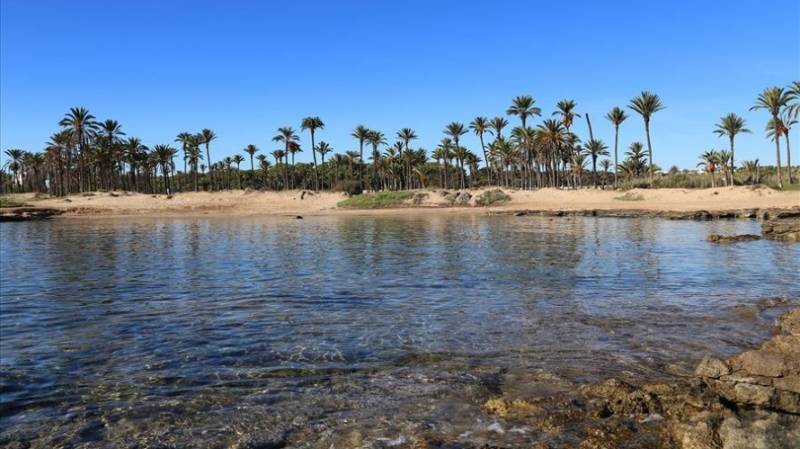
The Levante Dike harbour wall juts into the sea with a wide walkway on top to enjoy 360º views, then there’s the marina and port fronting the busy old town before coming around to Acequion beach and the great wooden jetty structure, the Eras de la Sal Historic Monument. The far side, Los Naufragos is another favourite stretch of fine white sands.
Meanwhile, to the south of Torrevieja town the bays are in a naturally peaceful setting, Cala Ferris is a large sandy stretch with dunes fringed behind by palm trees appearing like a seaside oasis, Cala Rocio is the extensive dog friendly beach, and finally sandy Cala Piteras bay brings an end to Torrevieja’s interesting coastline.
ORIHUELA – 16 kms coast
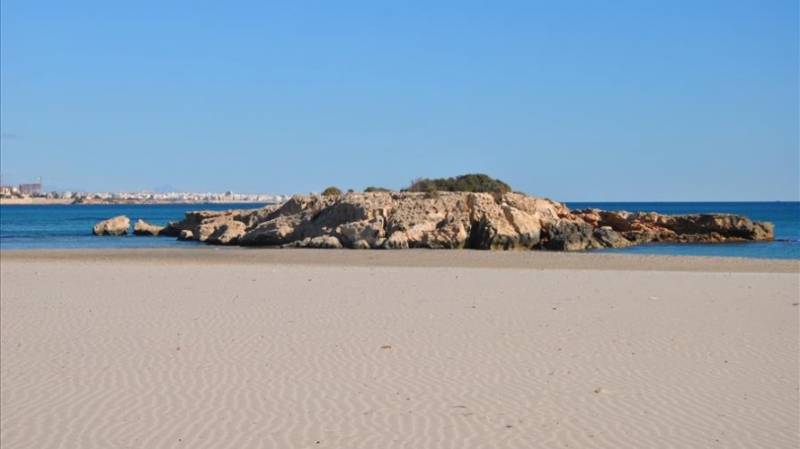
Orihuela Costa is a succession of 11 sheltered sandy beaches divided by small headlands on the shores of the Southern Costa Blanca. They boast a record number of blue flag beaches, the highest per kilometre in the whole of Spain – this is the European standard that marks not only the pristine conservation of the beach environment and quality of bathing water but also the excellent range of amenities and special facilities for invalids.
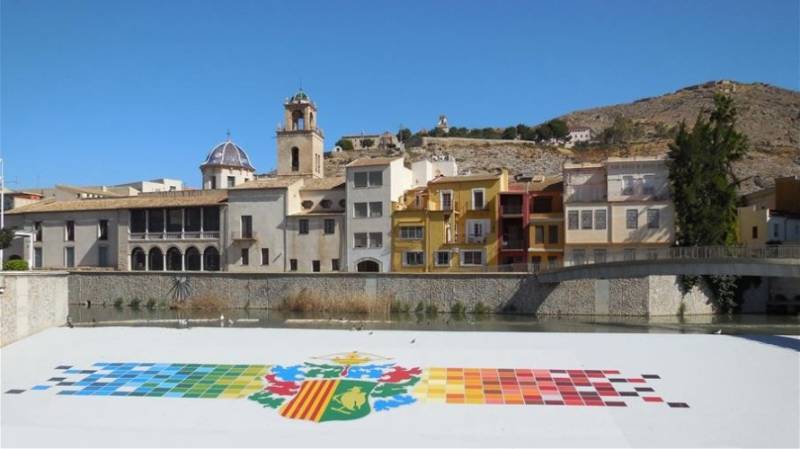
Orihuela City lies about 35 kilometres inland, a 40 minute drive away through the Vega Baja valley. The historical quarter straddles River Segura; an authentic Medieval marvel with sites of significant importance, the backstreets hide innumerable monuments to the past including monasteries, convents, churches, palaces and Orihuela Cathedral.
An open air museum dedicated to legendary local poet Miguel Hernandez, or the Sacred Art and Archaeological Museums are just some of the cultural attractions. Not surprisingly, the holy processions of Easter week are quite an atmospheric occasion. On a trendier note, tasting tapas with a glass of wine or dining in one of the fashionable eateries in the downtown riverside alleyways is a good plan to end the day.
Back to the beaches of Orihuela Coast.
The sheltered, sandy coves of Orihuela Costa are connected by seafront promenades and headland pathways… imagine walking or cycling the scenic route, eleven kilometres of sea views, pausing for lunch at a restaurant, taking a picnic to a different bay every day or having a bite to eat and a cool drink at a beach bar as the sun goes down in true Mediterranean style.
There’s no main town as such, but outlying urbanizations and focal points of social amenities such as shopping malls, restaurants and hotels, and a leisure harbour.
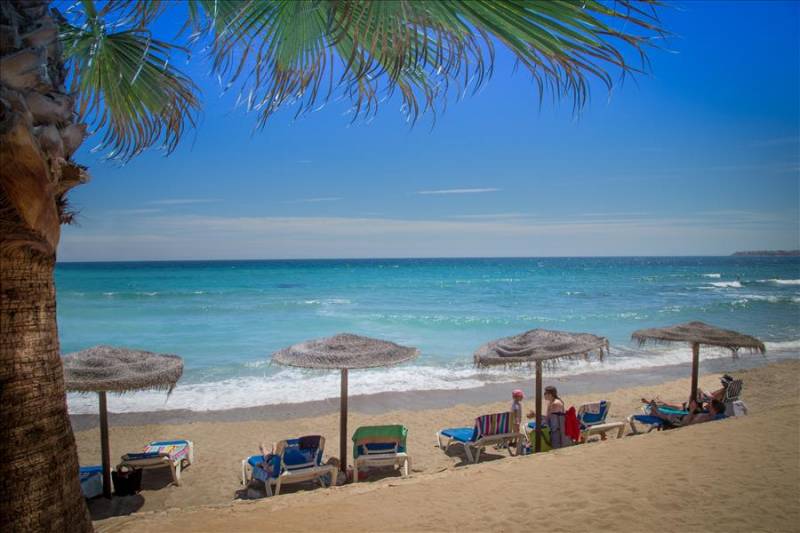
Punta Prima is the first beach down from Torrevieja around the small headland. For those with mobility problems, there is special elevator down to the sands from the boardwalk promenade where the coastal route towards Campoamor harbour commences.
Playa Flamenca area: Cala Mosca is a small cove with rocky areas at each end and footbridge access; pathways lead through the surrounding pine groves. Cala Estaca is a narrower, sandy cove that reaches right back to the promenade.
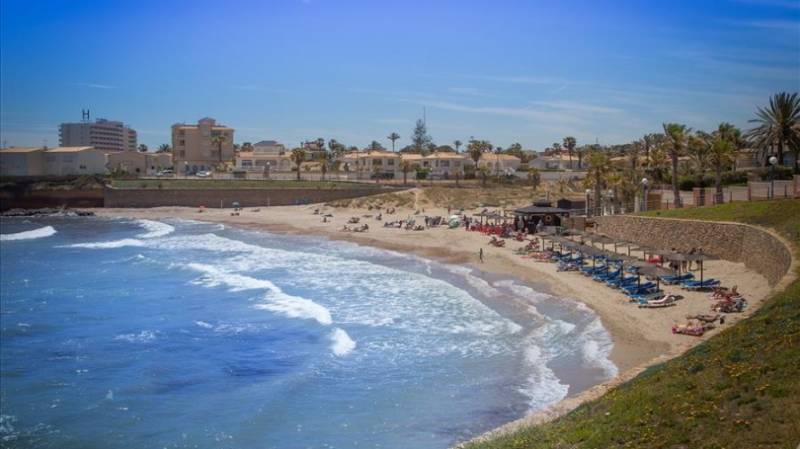
La Zenia area: Cala Cerrada is a secluded cove enclosed by rock walls. Cala Bosque is the wider ‘twin’ cove which is usually quite busy but fortunately has loads of space for playing ball games well away from the sun loungers; great for swimming and water sports, there’s a lively beach bar and nearby restaurants too.
Cabo Roig area: Cala Capitán is the soft sand cove with a tiny rock ‘island’ jutting into the shallows which children love to play on; convenient to get to if driving as there is a large adjacent car park. The ancient Cabo Roig tower watches over La Caleta, a broad cove sheltered by Cape Roig cliffs. The waters are ideal for paddling children and safe for swimming. It’s a popular place in winter too, particularly for playing beach sports.
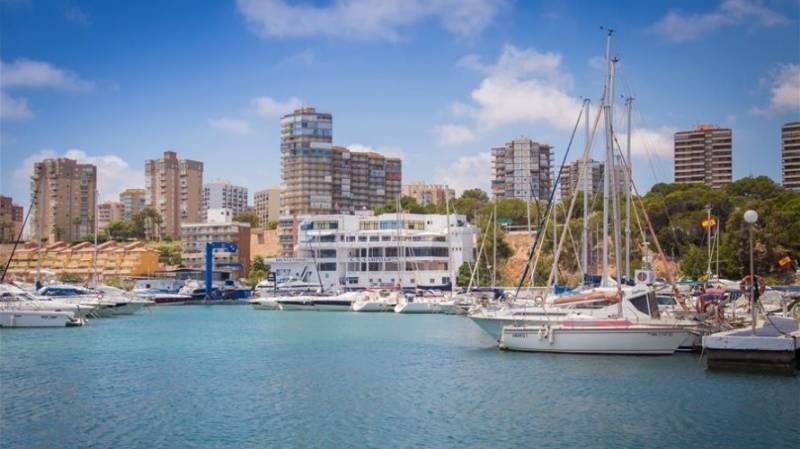
Dehesa De Campoamor area: Aguamarina is a quieter cove with golden sands and fossilized rock pools by the shore. La Glea is the sandy bay to the left of Campoamor marina. The well-equipped leisure harbour has some 350 berths and a nautical club that holds windsurf and sailing classes.
Barranco Rubio stretches along the shores to the south, an expanse of gold sands against a backdrop of green trees, making a pretty picture when the scarlet skies of sunset reflect on the aquamarine sea.
And finally, Mil Palmeras marks the end of Orihuela Coast – the name means ‘a thousand palms’, aptly describing this seaside oasis of exotic trees and desert-like sands reaching away to the ocean.
PILAR DE LA HORADADA – 5 kms coast
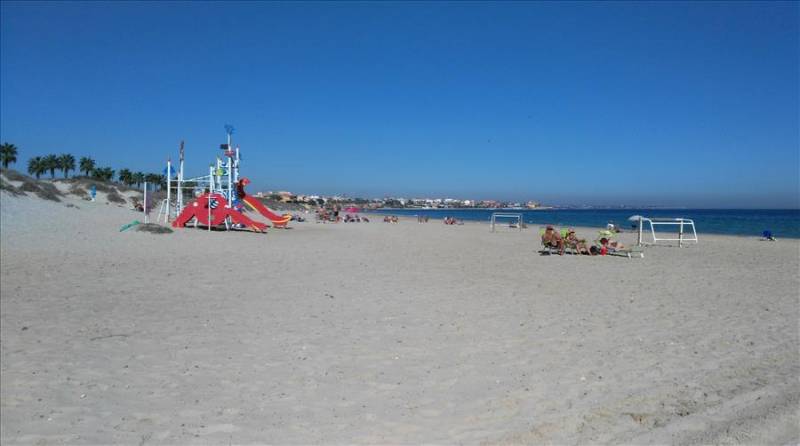
Pilar de la Horadada was a haven in Roman times for travellers on the Via Augusta, a place to break up the journey halfway between the cities of Illici and Carthago Nova, or Elche and Cartagena as we know them nowadays. This sector of the ancient trade route was paved with local stone cut from rock shelves, leaving shallow pools that you can still see today by the shores of El Rio beach.
This town is also a stopover on St James’s Way, southern pilgrimage route.
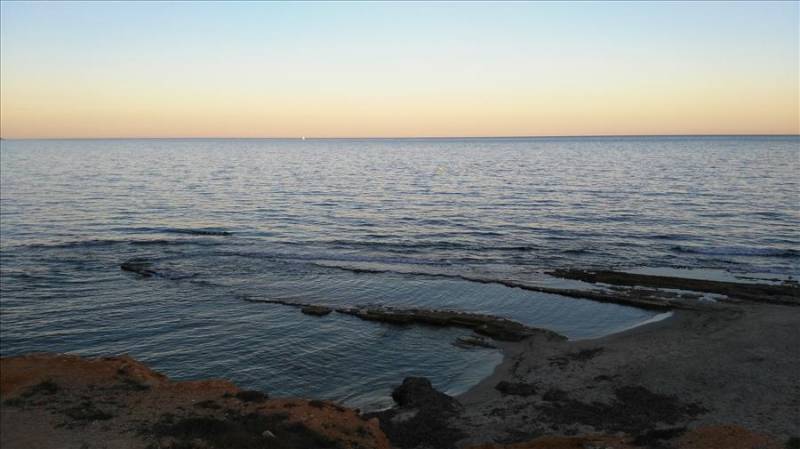
In this day and age, this laidback stretch of coastline is more likely to be invaded by the bucket and spade brigade in summer, and a ‘golden generation’ of languid adventurers looking to enjoy the winter sun. It’s a pleasant and peaceful destination all year round.
Five kilometres of coastline linked by seafront promenades and coastal paths, you can easily walk, jog, skate or cycle the whole length passing a succession of sheltered coves and sandy beaches which cover the most southern reaches of the Costa Blanca leading on to Murcia Region.
Shallow waters which are safe for toddlers, good accessibility for the disabled, beach game facilities, yachting clubs and golf courses, a great choice of eateries and sunny weather most days of the year make this a winner.
Vistamar is Pilar de la Horadada’s northernmost beach merging with Mil Palmeras, a family favourite with typical seaside attractions like pedalos, loungers and sunshades, kiddies’ play area, etc., as well as facilities for the disabled. A night market selling handicrafts is set up along the promenade on summer evenings adding to the fun. A designated ‘winter beach’, the Hibernis Mare scheme sponsors a range of free outdoor activities for everyone including yoga, zumba, skating and a host of outdoor games.
Continue along to Del Rio beach at the mouth of the dry riverbed where you can see the famous Roman rock pools. From here you can walk up into Pinar de Campoverde pinewoods.
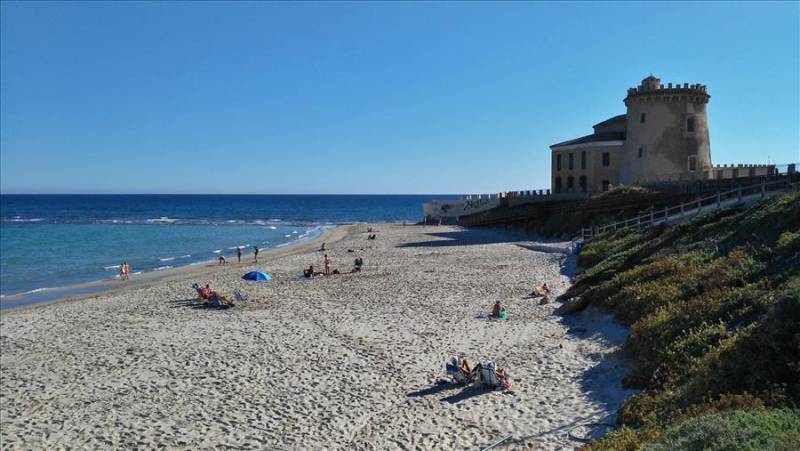
Calas de Rocamar is a succession of secluded rocky coves. From here a short walk around Puntal del Gato point comes out at Las Jesuitas, a broad expanse of sands with volley nets. El Conde is the sandy swathe under the protection of Torre de La Horadada.
El Puerto beach is on the other side of this XVI century watchtower, reached down a ramp beside the yachting harbour where a number of boating and yearly swimming events are held. The adjacent streets and plazas have a lively selection of restaurants if you’re looking for somewhere to eat.
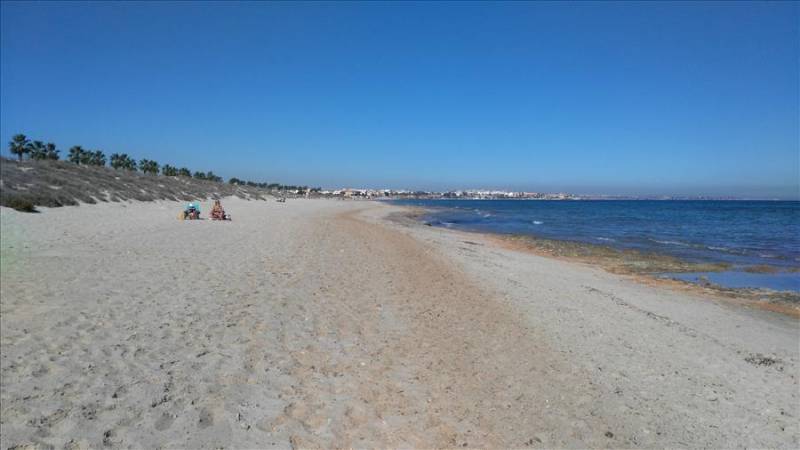
Three fine white sand beaches make up the most southerly bay describing to perfection the essence of the ‘Costa Blanca’. Las Villas is a timeless holiday favourite where kids can play happily making castles in the sand or go crabbing in the rock pools while the family lay back and relax.
Las Higuericas is a popular stretch of beach, great for a daytrip as there’s a big car park, disabled facilities, and children’s play areas on the sand. The attractive boardwalk promenade makes a lovely stroll or cycle ride.
El Mojón is the southernmost beach on the Costa Blanca, on the frontier with Murcia Province where the trails extend through San Pedro de Pinatar salt lake and sand dune nature reserve, towards the inland sea of Mar Menor.
Dog Beaches on the Costa Blanca
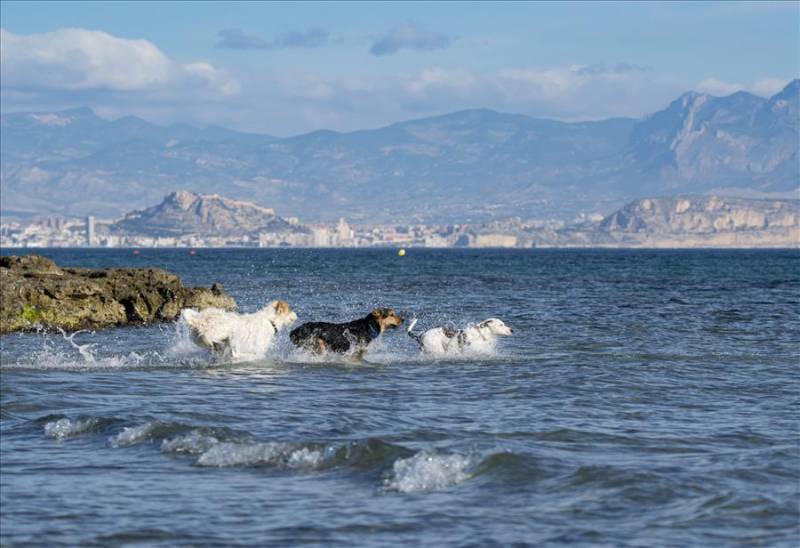
Although pets are not allowed on the majority of beaches in Spain, you’ll be glad to know that there are a number of specially designated beaches on the Costa Blanca where you can take your dogs for a walk or swim.
- Alicante – Playa Agua Amarga
- Altea – Playa L’Olla (designated dog zone)
- Calpe – Playa Les Urques
- El Campello – Punta del Riu / Barranc d’Aigües
- Santa Pola – Caleta Gossets
- Torrevieja – Cala Rocío de Mar
- Villajoyosa – Playa Xarco
Best Places for a Holiday on the Costa Blanca
It is impossible to summarize the vibes of each resort in the Costa Blanca, after all, there are 20 coastal towns and some 175 beaches to choose for your holiday. Everyone has their personal favourite, however the northern reaches of the Costa Blanca are perhaps more sophisticated, the central section from Calpe to Alicante plus Torrevieja probably the liveliest, and the southern stretches possibly the most relaxing.
Best nightlife and attractions: Dénia, Benidorm, Alicante, Torrevieja.
Best beaches for kids & families: Calpe, Villajoyosa, El Campello, Orihuela Costa, Pilar de la Horadada.
Best sandy beaches: Denia (Les Marines), San Juan, Elche Coast, Santa Pola, Guardamar.
Best coves: Javea, Teulada-Moraira, Benitachell, Benissa Coast.
Best picturesque setting: Altea Bay, Finestrat, Villajoyosa.
Best island: Tabarca
Best place for a holiday in Spain: The Costa Blanca!
A Few Facts About Costa Blanca
Costa Blanca is the name given to the 244 km coastal strip along Alicante Province, running from Dénia down to Pilar de la Horadada, in Southeast Spain.
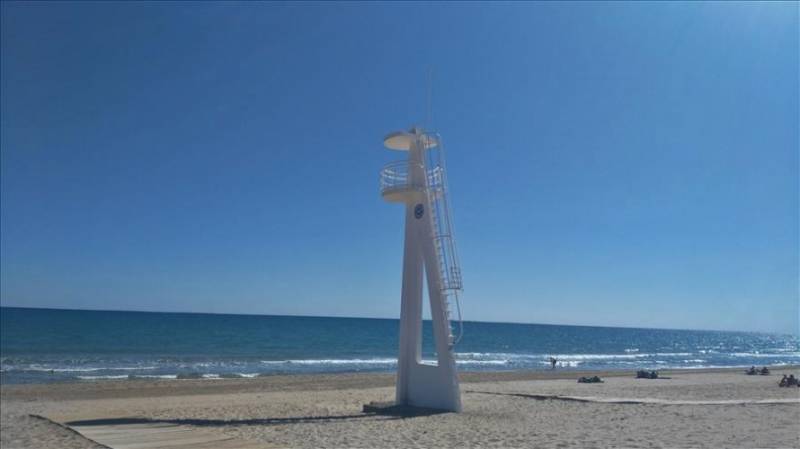
An amazing billion Euros is generated by tourists visiting the Costa Blanca each year, 50 percent of this by British visitors alone. Other nationalities that traditionally love coming here are the Dutch, German, Scandinavian, French, Italian, Portuguese, Belgian or Irish…but there’s also a new trend of holidaymakers and residents coming from Eastern European countries.
Many people of various nationalities have chosen to relocate to the Costa Blanca, to work or retire here, and this brings the interesting multicultural atmosphere that I love.
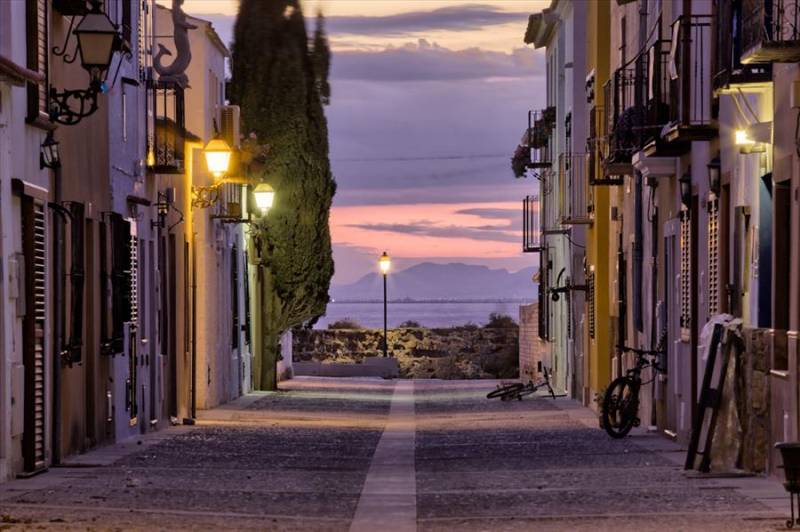
Climate on the Costa Blanca
The Costa Blanca enjoys almost 3,000 hours of sunshine annually, with average temperatures ranging from a mild 12C in January to 29C August…the weather is usually warm, sunny and pleasant, with little annual rainfall, the ideal climate any time of the year.
Summertime has perfectly hot weather for going to the beach or lazing by the pool, and for sea activities. Spring and autumn are still warm so you can combine a beach holiday with walks along the coast and into the mountains. Winters in Costa Blanca are generally mild making it the perfect destination for golfers, cyclists and rock climbers, or for pensioners looking for some warmth and sunshine.
Costa Blanca Gastronomy
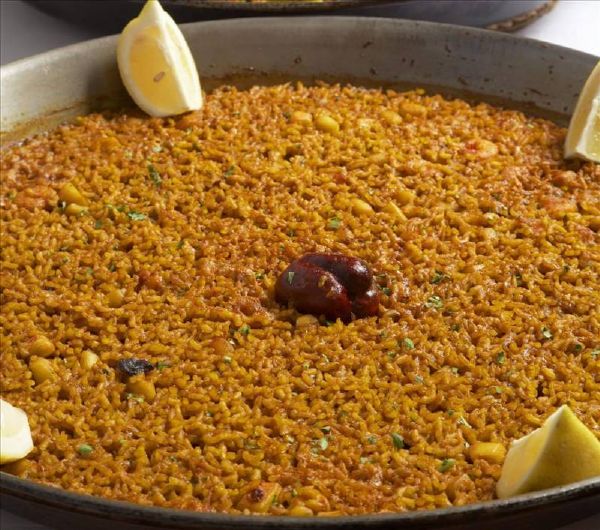
Did you know that authentic Mediterranean cuisine is wonderful as well as healthy? The traditional ‘Paella’ is a saffron rice dish served in a special flat pan which can include a variety of ingredients, the most popular along the Costa Blanca being seafood ‘marisco’, fish and chicken ‘mixto’, or chicken and veg ‘pollo’.
You’ll also find a tasty ‘paella de verduras’ which usually combines local sun-ripened vegetables including artichokes with a handful of butter beans. Arroz a Banda is a local specialty, the exquisite taste comes from sea fish used to make the stock.
Summer starters could include a fresh tomato and lettuce salad with all the trimmings, a plate of grilled sardines, a bowl of steamed mussels, tangy ‘gazpacho’ cold tomato soup, or a small dish of ‘espencat’ comprised of grilled red peppers, aubergine, tomatoes and onion drizzled in olive oil. Ask for ‘pan con alioli’ crusty bread and garlic mayonnaise on the side. Or choose seafood ‘sopa de marisco’ if you fancy hot soup.
Tapas are another favorite… the tasty bite sized aperitifs are often served on bread to accompany a glass of cava, lager or wine. Or choose a selection of portions to share for lunch, such as the typical potato mayonnaise salad, Spanish omelette, spicy sausages, battered squid rings, a platter of cheese and ‘serrano’ ham, deep fried croquettes, and many more.
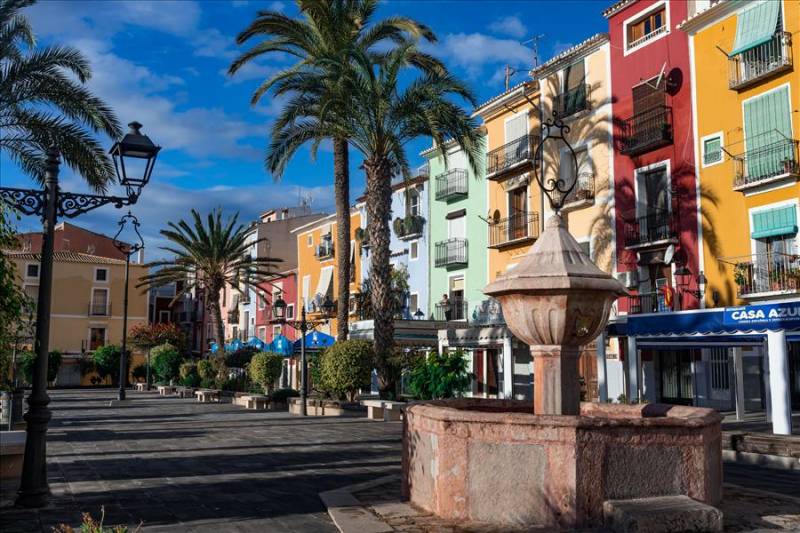
Specialties include locally caught Mediterranean fish (sardines, red mullet, whiting, mackerel, gilthead bream and calamari among others), traditional rosemary roast lamb with Spanish style pan potatoes, fresh Dénia prawns and sea urchins, and almond based desserts such as ‘turron’ icecream, or fresh seasonal watermelon, oranges, mandarins, and medlars straight from the orchards.
Oven-baked savoury pastries and typical cookies are also popular, each town or village having their own local recipes.


An array of international restaurants caters for every taste and pocket too, from burgers to pizza to kebab, Indian or Moroccan, Chinese or eat-as-much-as-you-like ‘Asian’, and virtually everything European including English fish and chips! And don’t forget the Spanish staple takeaway, a delicious roast spit chicken!
Beachside ‘Chiringuitos’ are a tremendous success in the summertime, the place to grab a ‘bocadillo’ (filled crusty bread stick), enjoy a casual meal, or just relax with a cool drink listening to the lapping waves until the early hours of the morning.
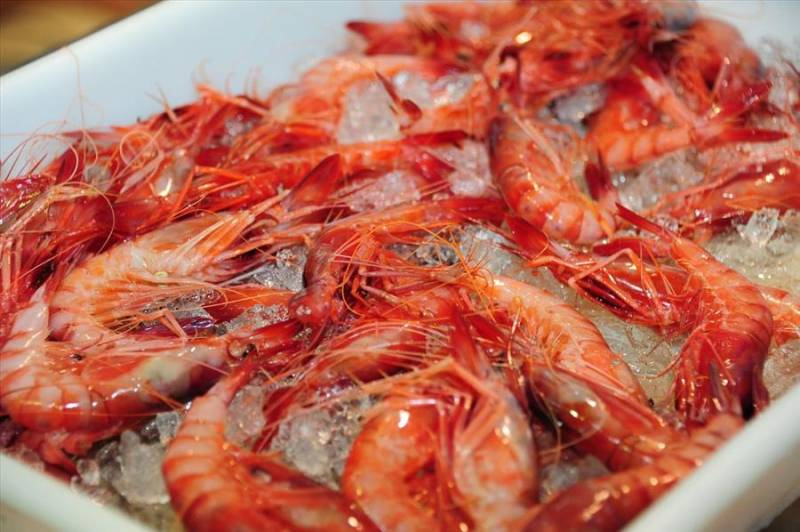
As well as laid back eating experiences, the Costa Blanca has some seriously culinary gems starred in the Michelin Guide -12 world class restaurants found in Elche, Alicante, Calpe, Jávea and Dénia, or La Nucía, Ondara and Cocentaina (these last 3 are inland)- where Spain’s top chefs cleverly blend traditional recipes with innovative gourmet trends.
Dénia is actually a UNESCO ‘Creative City of Gastronomy’, a culinary destination with some 300 restaurants and a long list of gastronomic events. Alicante city has a zone of trendy gastrobars and pubs in the old town walking streets.
Wine Tourism – Alicante Designation Of Origin
Alicante has a history of winemaking that goes back to 600 BC! There are two distinct vine growing areas where the different microclimates and soil nutrients produce a diversity of grape varieties.
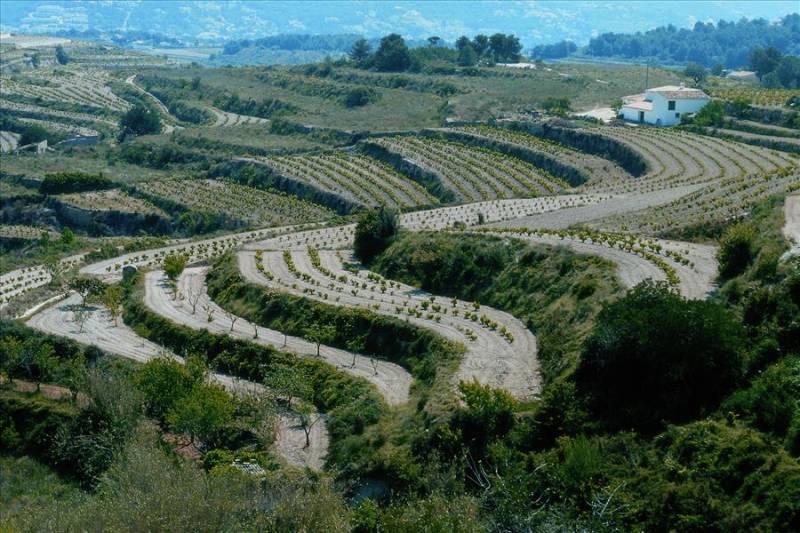
Vineyards in the Marina Alta region are influenced by their proximity to the sea, grown on hillside terraces and in the valleys. ‘Moscatel Alicante’ is a sweet amber coloured dessert wine made from the Alexandria Muscatel grape and is known locally as ‘Mistela’.
This versatile grape variety is also used to make excellent dry whites, the local ‘Marina Alta’ brand is presented in a stylish slim bottle and is elegantly fresh tasting, and dangerously moreish!

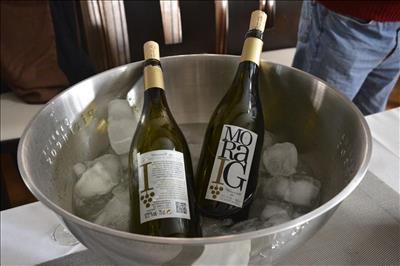
In contrast, ‘Tinto Alicante’ is a smooth, full bodied ruby red wine made from the Monastrell grape variety produced by bodegas in the Vinalopó region, inland from Alicante city where the climate is drier. Fondillón is a prime vintage red wine with a 16% alcohol content elaborated biologically from the slow maturing grape, fermented without additives and naturally aged in wooden casks for a minimum 10 years.
Bodegas Cerdá in Hondón de las Nieves.
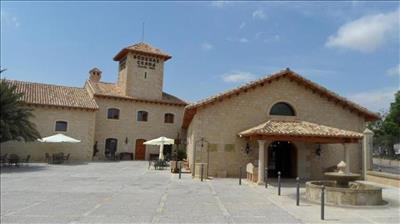
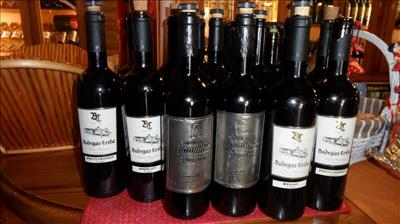
Follow the Alicante Wine Route through the province, visit the different wineries to learn about the Mediterranean heritage of winemaking passed down generations of winemakers, see the vineyards and enjoy the wine tasting sessions.
Costa Blanca Castles
Visigoth Kings, Roman Emperors, Arabic Sultans and Christian Monarchs have ruled the lands of Alicante since time memorable. Their legacy includes a wealth of ancestral sites, castles and forts, walled towns with palaces and churches, citadels, watchtowers and defensive bunkers, scattered throughout the Costa Blanca.
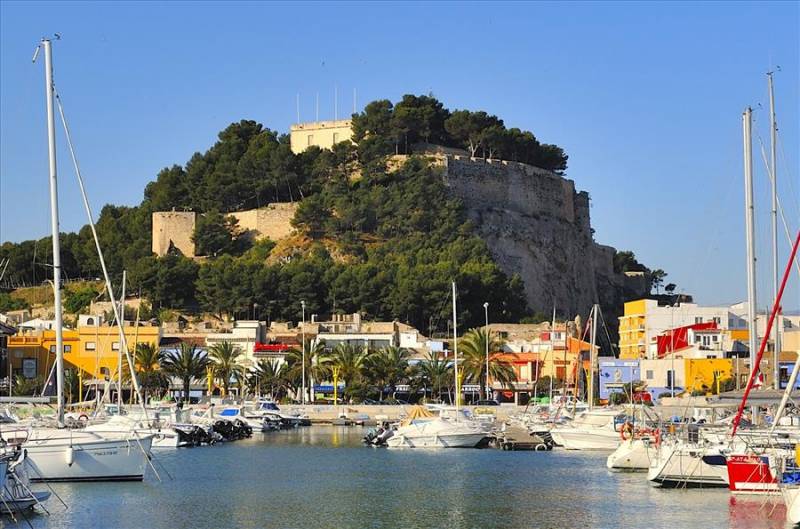
Santa Barbara Castle in Alicante City and Dénia Castle both overlook the Mediterranean coast, together with a series of watchtowers marching down the entire length of Costa Blanca. There are dozens of inland castles in different states of repair…some are just ruins reached on a walk through the mountainside while others are well maintained and can be seen properly on a visit.
Villena Castle is particularly worth seeing on a guided tour to learn about the local history. Biar Castle is smaller but definitely a must-see as it’s only 20 minutes away from Alicante in a totally rural village setting.
Watersports on the Costa Blanca
The ideal place for practicing water sport of all kinds, the Costa Blanca has facilities for most nautical activities; yachting and leisure craft, windsurfing, kayaking, snorkeling, scuba diving, waterskiing, jet-skiing, kite-surfing, fishing and more… or just relax and have fun on a pedalo!
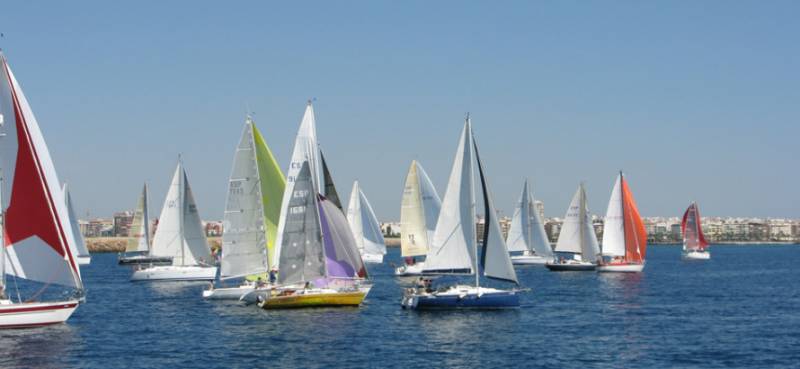
Jet ski, stand-up paddle, kayak, windsurf, sea fishing, yachting, sailing, rowing, water-ski, windsurf, wakeboard, motorboats, diving or snorkeling are just some of the water sport activities waiting to be enjoyed up and down the Costa Blanca.
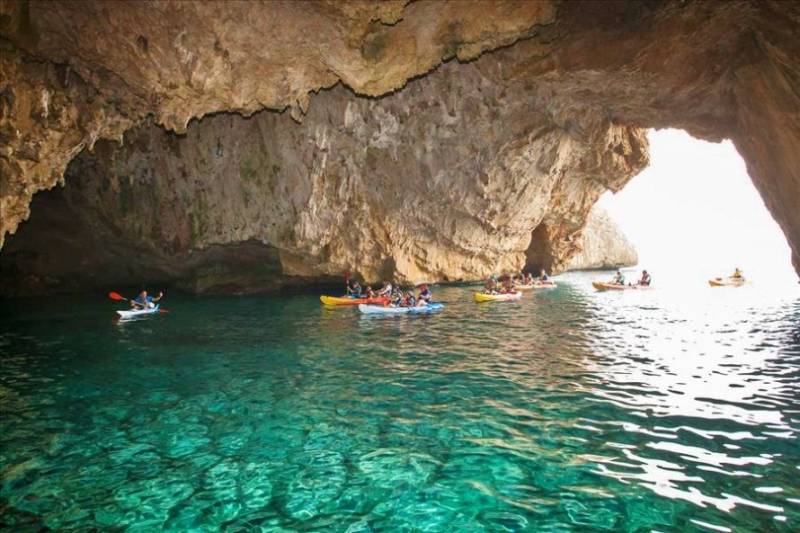
With literally something for everybody who loves getting wet, you can practice your abilities on Benidorm’s Levante beach CableSki, check out the nearest nautical club, contact a diving centre, surf your kite on the open waves, book a charter or excursion, or don your goggles and discover an underwater world in the rocky coves. Or just pedal out on a giant flamingo and slide into the sea if you fancy a splash on a hot summer’s day.
Dive Sites and Snorkel in Costa Blanca
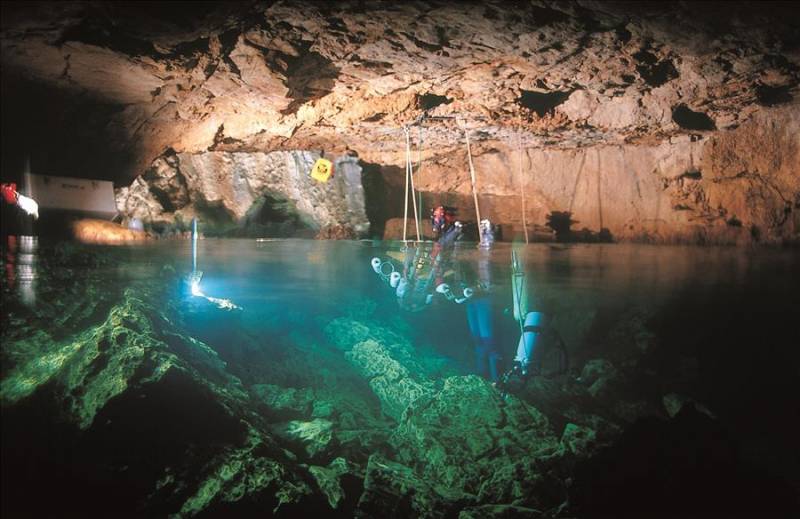
The Valencian Region has 600 kilometres of coastline, 3 marine reserves and other protected areas of seabed, and 30 plus diving destinations. The Costa Blanca’s mild climate and habitually calm sea conditions makes it an ideal destination for divers. There are authorised diving clubs in most resorts where you can learn to scuba dive, or simply enjoy some snorkelling fun in the warm Mediterranean sea during the hottest summer months.
Yacht Clubs and Marinas on the Costa Blanca
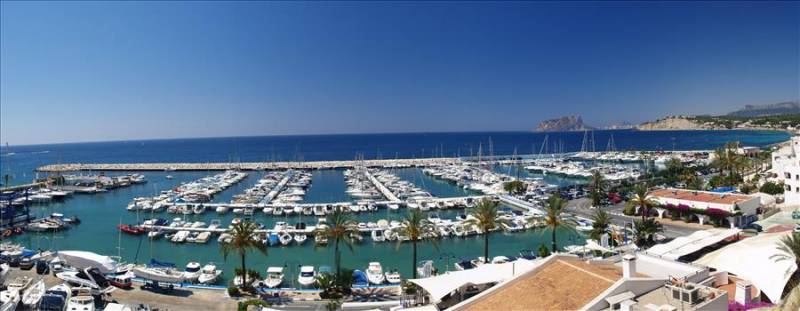
If you sail your own boat, take a look at our chart to see the variety of marinas and yacht clubs along the Costa Blanca and where they’re located.
Outdoor Sports and Activities on the Costa Blanca
Golf on the Costa Blanca
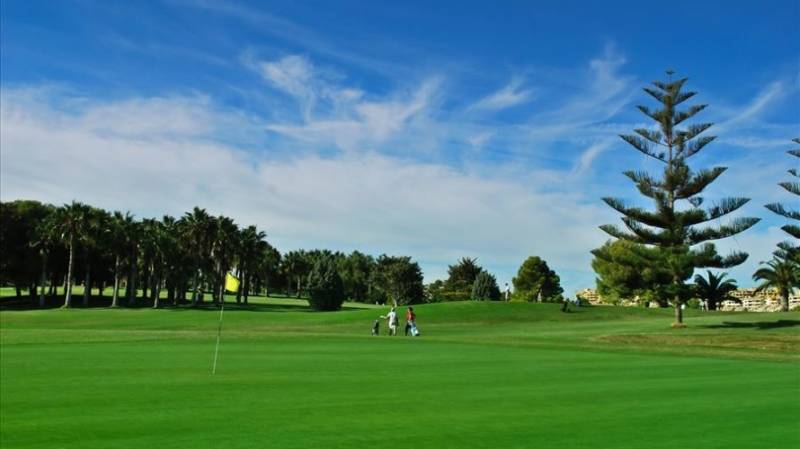
Costa Blanca has more than 20 golf courses which are ideal for play throughout the year, several of these designed by world class golfers including Jack Nicklaus or Severiano Ballesteros.
The golf clubs are in stunning locations, natural surroundings between the mountains and sea; some are part of exclusive resorts or on luxury residential estates (which makes it perfect for a special golfing holiday) and are open to visiting golfers with prior reservation subject to availability.
The majority of the clubs are part of the ‘Association of Golf Courses in the Costa Blanca and the Costa Blanca Golfing Friends Club’ – website in English: Association of Costa Blanca Golf Courses
Cycling Routes on the Costa Blanca
Alicante Province has a diversity of terrains and a sunny climate which makes it a favourite destination for European cyclists. Spain’s top cycling event, ‘Vuelta España’ invariably races this way.
Fancy pedaling by the beach or mountain biking up the trails? Whether you’re a weekender on a pushbike, a family on a sedate outing, pensioners on your ebikes, or a professional cyclist looking for a challenge, it is fun riding a cycle on the Costa Blanca.
The endless peaks and valleys are what cyclists’ dreams are made of, and a number of hotels in Dénia, Calpe or Benidorm for example, cater for this type of specialist holiday. Alicante is the second most mountainous region in Spain and a brilliant place for training. However, the coastal routes are the main attraction for the less energetic majority!
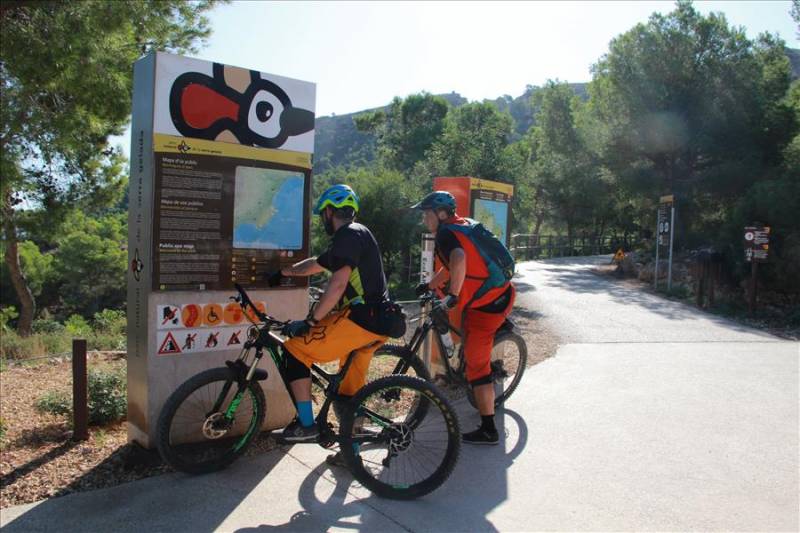
Take Altea Bay as an amazing example… a 2.5 km ride along the paved cliff walk to El Albir Lighthouse on Sierra Bernia is always a joy. There’s a level cycle path by the seafront that runs from El Albir to Altea which is suitable for absolutely everyone, the promenade is wide enough for wheelchair users too.
Commonly known as ‘Altea River’, the Algar Estuary is at the far end of the waterfront and from here you can follow the riverside inland or along the coast to L’Olla de Altea beach.
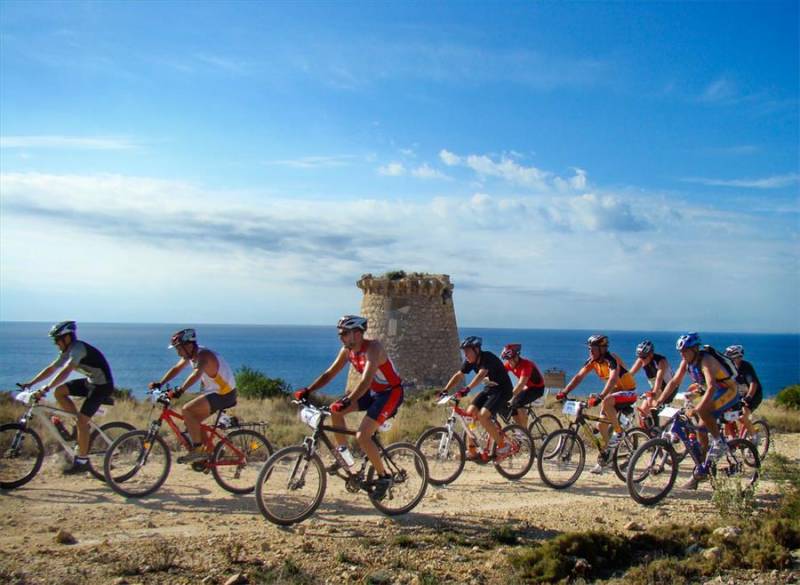
The southern stretches of the Costa Blanca are also cycle friendly (it’s fairly level so you don’t have to be super fit!). Torrevieja has a wonderful cycle route around La Mata Salt Lake, the dirt paths crossing pinewoods, shady picnic areas, and bird spotting outlook points for flamingo watching. It makes a lovely day out for all abilities.
And as we mentioned in the beach section above, you can get on your bike and pedal the vast majority of the coastal path from Torrevieja to Pilar de la Horadada – the idea is to take it gently, one stretch at a time.
The Northern Costa Blanca has a more abrupt coastline with some interesting cycle routes from Dénia down to Jávea and Calpe, or inland to the beautiful Jalón Valley. Follow Dénia’s ‘via verde’ green route by the old railway line past orchards and the wetlands of Pego Nature Reserve, then carry onwards to Las Marinas beach, a 6 kilometre ride all-in-all.
Tip:
There are bicycle hire shops in most coastal resorts along the Costa Blanca. Anyone who wants to bring their professional bike on a flight over to Spain should check the special baggage conditions with their airline carrier, and mention this when booking an airport transfer service.
Best Walks in Costa Blanca
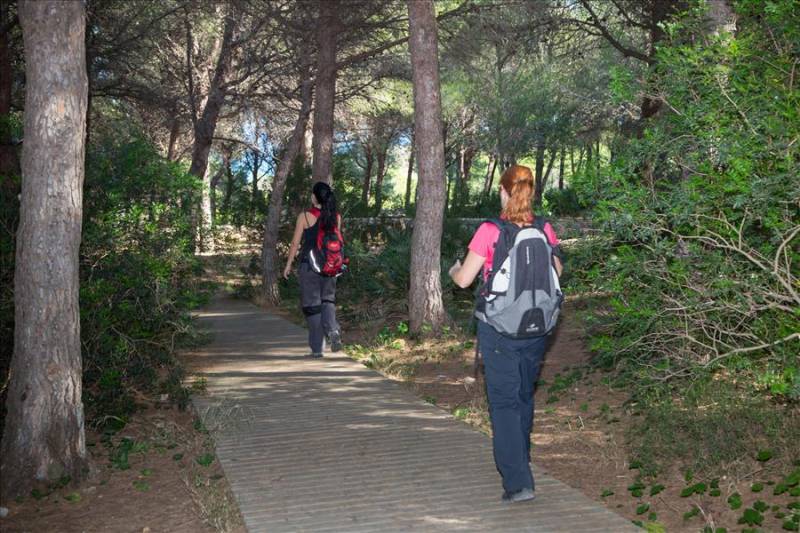
Costa Blanca has some of the best places for walking in Spain – while you can obviously walk all the cycle routes mentioned in the section above (around the pink lagoon and La Mata salt lake in Torrevieja for example), there are an infinity of other paths to enjoy on foot. Magnificent walks along the sandy beaches mentioned in the coastal resorts section above include the Santa Pola – Elche coast down to Guardamar and Torrevieja.

Here’s a list of the most popular Alicante walks, nature trails and treks within easy driving distance from the coast.
- Mount Montgó, Dénia – Jávea
- Ecological Coastal Walk, Benissa
- Peñon de Ifach, Calpe
- Sierra Bernia Fort, Benissa – Altea
- Altea Night Walk, Guadalest – Altea
- Sierra Helada Ridge, El Albir – Benidorm
- Puig Campana Peak, Finestrat (near Benidorm)
- Sierra Aitana, near Guadalest Valley
- El Hondo Wetlands Nature Trail, Elche
- Southern Costa Blanca Coastal Paths
Stroll gently through woodland walks that take you past windmills and watchtowers, along clifftop paths overlooking the Mediterranean, on nature trails across dunes and marshes, or for miles down the sandiest beaches imaginable. And if you love the adventurous life, head for the hills to climb the crags, trek to the heights of Alicante mountains and capture the joy of reaching the top.
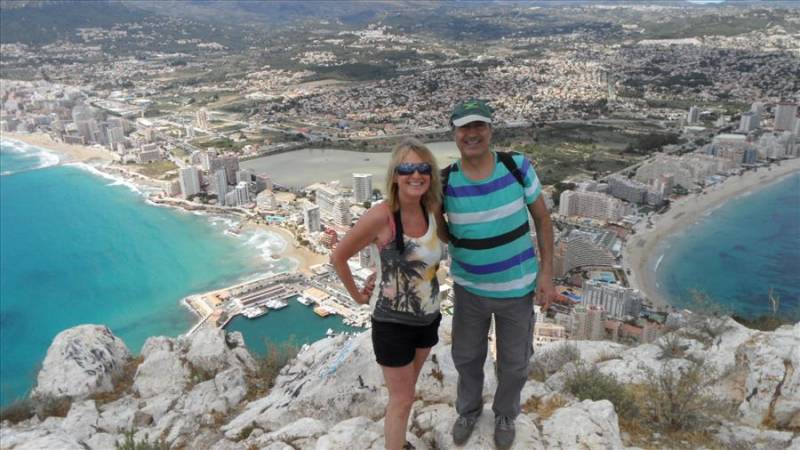
Paragliding in Costa Blanca
Costa Blanca is a wonderful destination for paragliding. There are various flight zones over the coast and inland. Expert pilots have several exciting spots to choose from – Morro de Toix overlooking Calpe coastline or Alt de Sella for a flight over the mountains, for example.
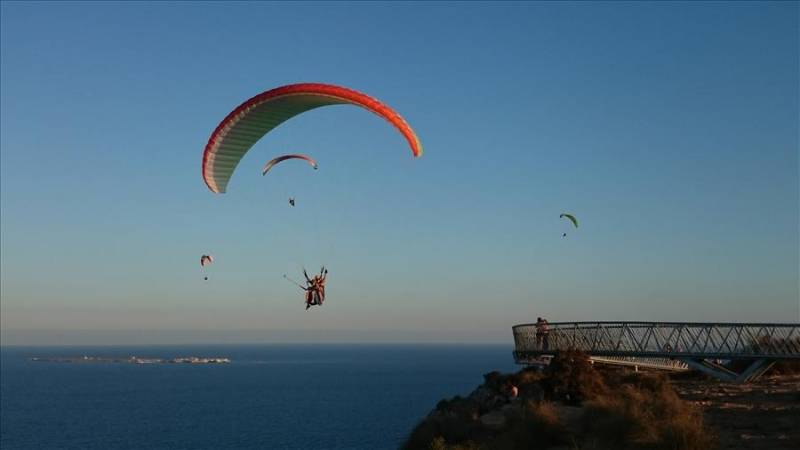
Cape Santa Pola or Agost (inland from Alicante city) are favourite launch sites for both experienced paragliders and beginners.
Those with less experience (or on holiday without equipment) should book a flight with Parapente Santa Pola, a licensed paragliding company with offices in Gran Alacant. In fact, Santa Pola and Agost are popular for tandem paragliding. Beginners are strapped into the paraglider with a trained pilot for a 20 minute flight, it’s an amazing and affordable adventure activity.
If you want to learn how to paraglide, there’s a 7-day introductory course with an instructor that includes paraglidng lessons. This can conveniently be done at weekends, for example, for anyone living on the Costa Blanca, or daily for those on holiday.
Rock Climbing in Costa Blanca
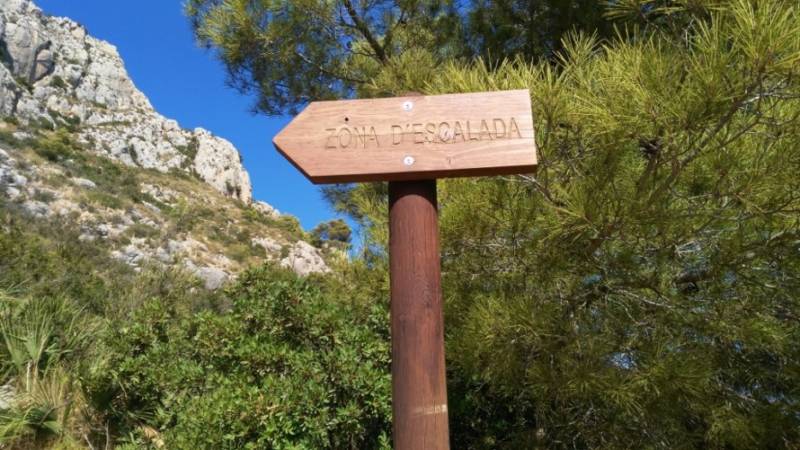
Alicante has 26 tall mountains over 1000 m high!
No wonder rock climbers love it here, it’s a good destination with quality routes many within a short distance of the coast. These are just some of the places to look out for:
Calpe has a total of eight crags and some 400 routes. The most famous is the Peñon de Ifach, a 300 m high rock which rises steeply from the Mediterranean Sea and affords exceptional multi-pitch climbing with a choice of trad or sports climbs. A total of eight crags around the town include the sea cliffs at Morro de Toix and Mascarat.
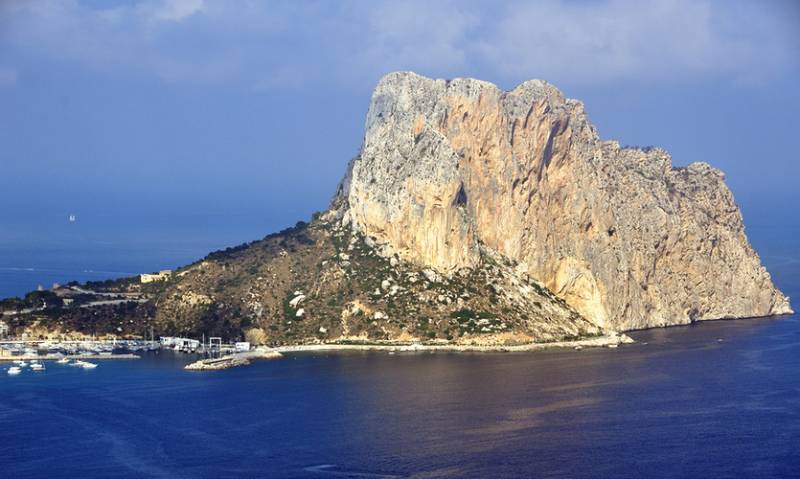
Around the Jalón Valley there are six crags and 200+ routes which are excellent for single pitch face climbing. This includes rock walls at Bernia, Peña Roja and Alcalalí.
Benidorm is centrally placed if you’re looking for some serious climbing. There are eight crags in the Marina Baja district and more than 750 routes! Puig Campana has long multi-pitch routes which are brilliant for traditional climbs.
A little further inland, the crags on Ponoch (near Polop) and by Guadalest have a choice of 200 routes between them. However, the crag at Sella is considered to be the best in the whole area, some 300 routes which offer an option for every level, short and easy climbs for beginners to long multi-pitched routes for advanced climbers.
Costa Blanca Protected Nature Parks
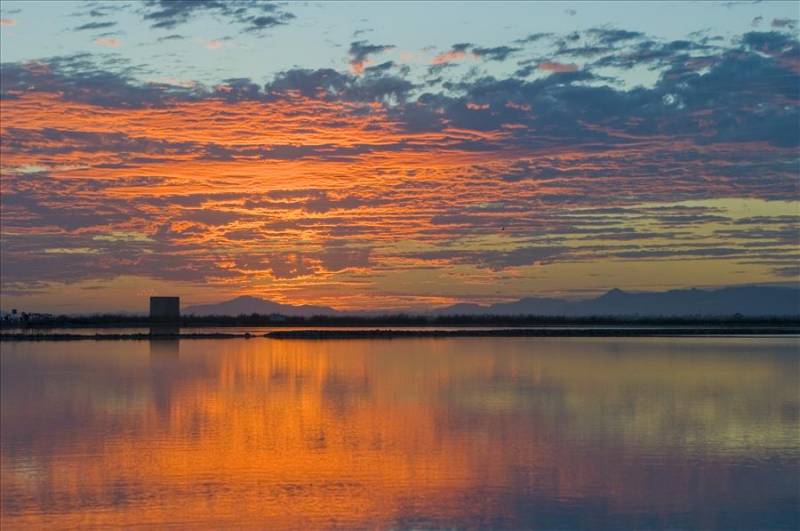
Alicante has 11 protected nature reserves, seven of these are on or near the coast, two are Marine Reserves, and two are inland near the city of Alcoy.
Costa Blanca Nature Parks from North to South
- Pego-Oliva Marshes – El Marjal Pego-Oliva
- Mount Montgó – El Montgó
- Calpe Rock – El Peñón de Ifach
- Sierra Helada – Serra Gelada
- Santa Pola Salt Lakes – Las Salinas de Santa Pola
- El Hondo Wetlands – Fondo de Elche
- La Mata and Torrevieja Lagoons – Lagunas de la Mata y Torrevieja
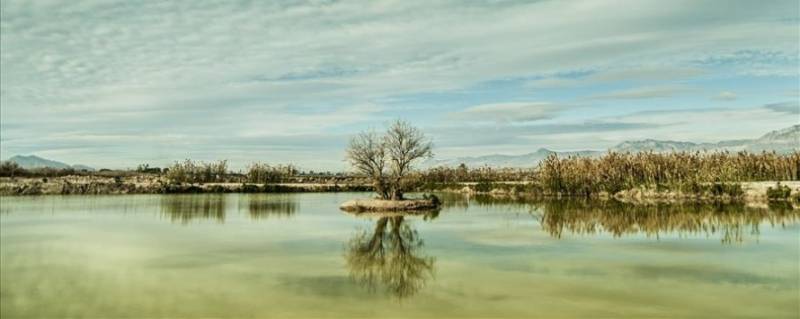
Marine Reserves
- Cabo de San Antonio headland
- Tabarca Island
Two marine reserves, the island of Tabarca to the south and the Cabo de San Antonio headland to the north are places where it’s easy to spot deep sea species such as the Balearic shearwater (Puffinus mauretanicus) and the European storm petrel (Hydrobates pelagicus).
The Ibiza Channel is a Specially Protected Area of Mediterranean Importance and a stopover location for marine mammal species like dolphins and fin whales (Balaenoptera physalus).
Inland Nature Parks of Alicante Province
- La Font Roja
- Sierra de Mariola
Inland Costa Blanca
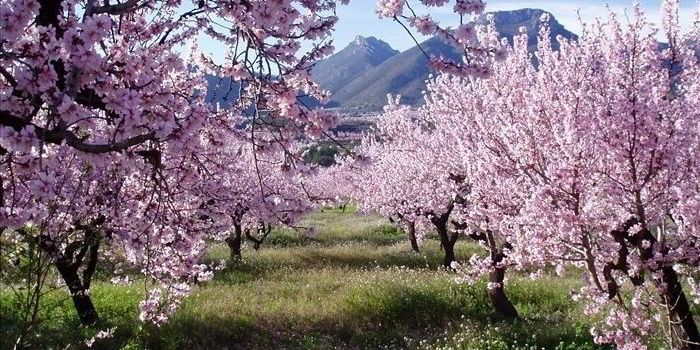
Discover inland Alicante too… drive into the countryside and mountains away from the coastal strip, wander around rural market towns and sleepy hamlets where the traditional way of life continues, visit the castles and old churches.
Drive inland from Benissa to see the almond blossom and vineyards in Jalón Valley The villages of the Guadalest Valley are particularly beautiful too and easy to reach by car – venture even further inland to glimpse ‘real’ Spain where tourism barely exists.
History of the Costa Blanca
The Costa Blanca has a history of ancient civilizations and convoluted events that has been recorded since 1000 BC.
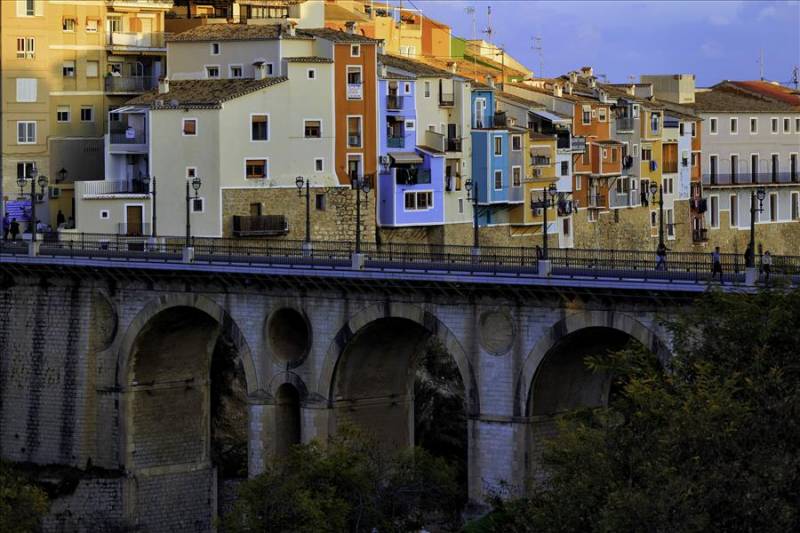
Greek and Phoenician merchants sailed the coasts of the Costa Blanca three millenniums ago. They built harbours to protect their vessels and many settled along the Mediterranean ‘white coast’ gradually spreading their cultures throughout the Iberian Peninsula. The Romans marched in around 3 BC, constructing roads and the salting fish industry.
The Visigoths pushed into Hispania as the Western Empire fell (472 AD). The Goths retreated and the Moors took control in the 8th century, until Christian troops from Castille battled their way back in the ‘Spanish Reconquest’ (1246). The King of Aragon ruled for a while until Alicante finally became part of Valencian Kingdom in 1298.
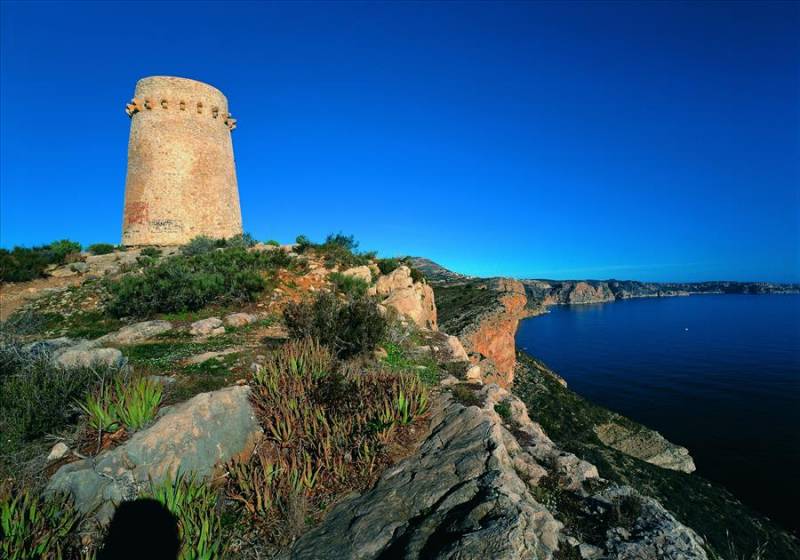
Watch towers went up in the 16th century to keep raiding Barbary pirates at bay, dotted along the coast they can still be seen today. In more recent times, the Spanish Civil War fought over the Costa Blanca, port cities Dénia and Alicante were attacked from the air causing chaos and strife (1938). For almost 100 years now, the Costa Blanca has lived in total peace, a prospering paradise raided solely by tourists.
Fun Fact
Costa Blanca was part of the original Spania – in the 6th century the coastal region down to Cadiz together with the Balearic Islands and Ceuta was known as Spania Province, part of the Byzantine Empire.
Archaeological Sites and History Museums in Costa Blanca
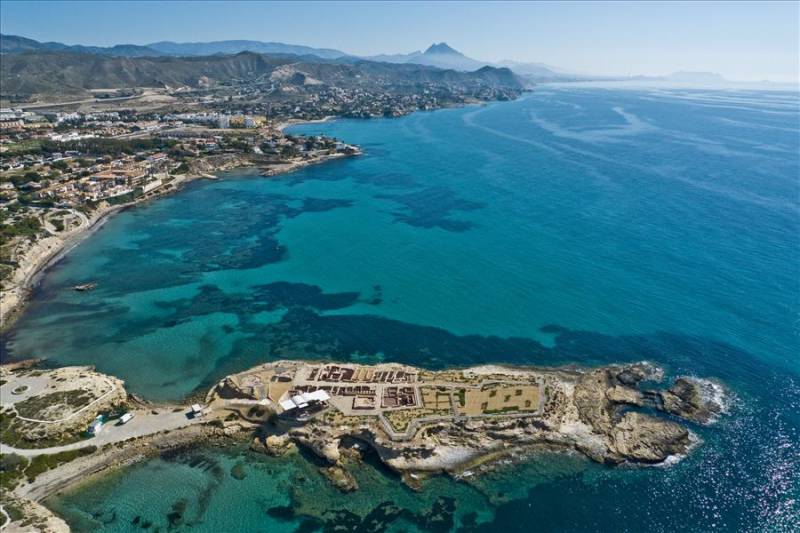
- Alicante – Tossal de Manises (Lucentum)
- Alicante Archaeology Museum MARQ
- Dénia Castle and Archaeological Museum
- Calpe – Baños de la Reina
- El Campello – La Illeta dels Banyets
- Xàbia – Soler Blasco Archaeological and Ethnographic Museum
- Elche Archaeological and History Museum of Elche (MAHE)
- Guardamar Archaeological Museum (MAG)
- Pilar de la Horadada Archaeological and Ethnographic Museum
Lighthouses of the Costa Blanca
There are 7 lighthouses along the Costa Blanca which have traditionally guided sailors to safe harbour on dark and stormy nights. Take a picture outside the ‘faros’ on Benidorm and Tabarca when you get a boat over to the islands, drive up to Cape San Antonio and Cape La Nao if you’re visiting Jávea or to Santa Pola lighthouse which overlooks the southern Costa Blanca.
Walk around the headland between San Juan beach and Alicante city to see the beacon on Cabo de la Huerta or take a stroll along the cliff walk to Albir lighthouse where there is a free-entry visitors centre – learn the history of the local lighthouse keepers and their families, as well as the marine reserve in Altea Bay. Keep a lookout for the dolphins playing in the waves down below!
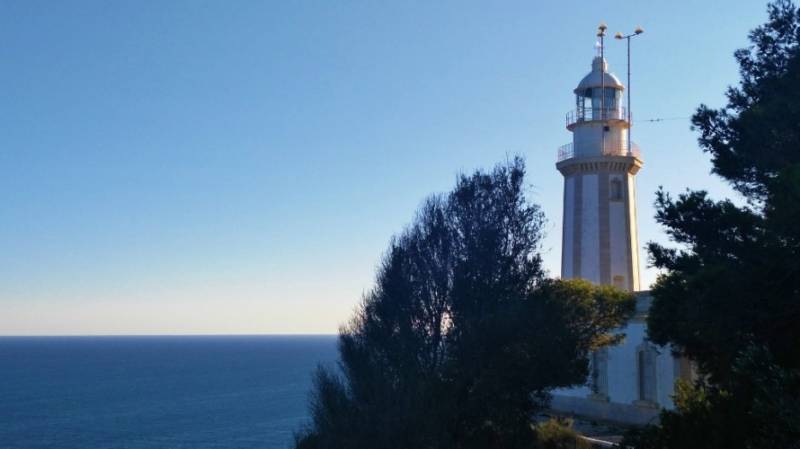
Costa Blanca Lighthouses from North to South
- Faro Cabo de San Antonio, Jávea
- Faro Cabo de La Nao, Jávea
- Faro de El Albir
- Benidorm Island lighthouse
- Faro de Cabo de la Huerta, Alicante
- Faro de Santa Pola
- Tabarca Island lighthouse
Festivities and Fireworks on the Costa Blanca
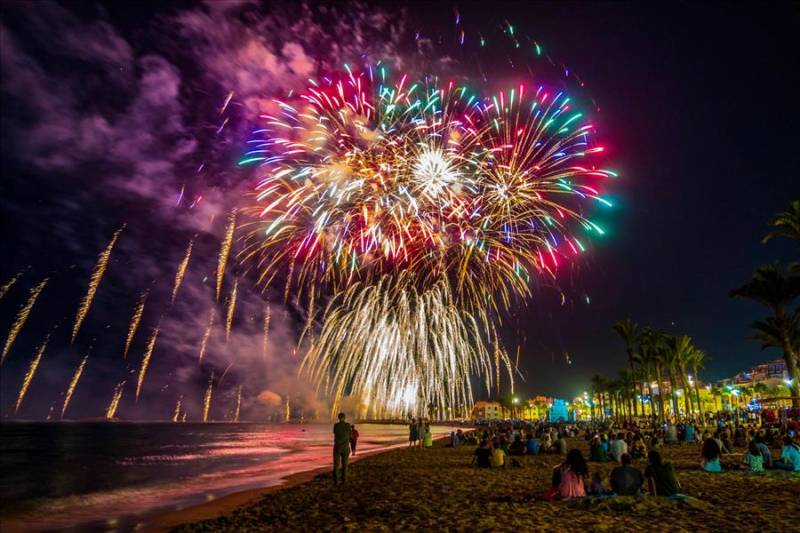
There are literally hundreds of local festivals every year on the Costa Blanca where you can join in the fun. The August firework display in the sea by I’Olla beach in Altea is world famous.
Every town and village has its own traditional fiestas, the most notable are San Juan celebrations which lead up to 24 June (Alicante city and many other towns); Fallas Fiestas (traditional Valencia fiesta celebrated widely across the region, culminating on 19 March); Moors & Christians parades and festivities are played out in many towns, the Villajoyosa sea battle is memorable in July.
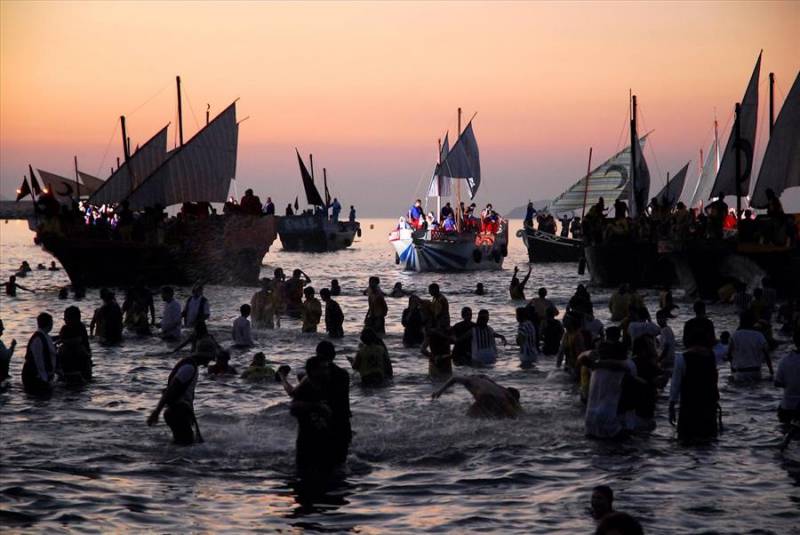
Dénia and Jávea feature ‘Bous al Mar’, popular bull running events where local youngsters invariably end up in the sea. Benidorm always seems to have some street party going on (main one is in November) while Calpe is obligatory for the October Beer Fest.
A wide variety of musical festivals include everything from trendy Electrobeach in Benidorm to traditional Habaneras in Torrevieja, a melodic tribute to the sailors.
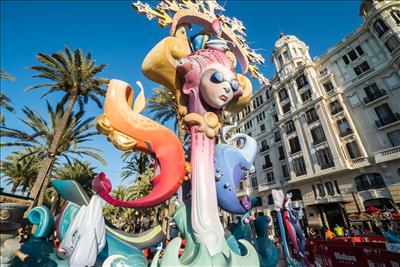

San Juan ‘Hogueras Fiestas’ in Alicante City – Photos courtesy of Alicante Tourism Board
Easter processions are mega in Orihuela and Elche (don’t miss the Misteri D’Elx medieval lyrical dramas at Elche Basilica on August 14-15 either). Christmas and New Year celebrations in Costa Blanca are held in true Spanish style, with local Xmas markets to get your goodies and ornate nativity scenes.
Costa Blanca Theme Parks
There are 8 unique theme parks on the Costa Blanca – Benidorm’s Terra Mítica is one of Spain’s major theme parks, a gigantic funfair set against a backdrop of ancient Mediterranean cultures; Aqualandia, Aqua Natura and Aquapolis are the water parks to visit in Costa Blanca, making a fun day out and great way to cool off in the summer sunshine; for animal lovers there’s Mundomar sea world and the exotic Terra Natura as well as Rio Safari Elche and Safari Aitana wildlife parks (this last one is up in the mountains towards Alcoy).
- Terra Mítica Benidorm
- Mundomar Benidorm
- Aqualandia Benidorm
- Terra Natura Benidorm
- Aqua Natura Benidorm
- Aquopolis Torrevieja
- Pola Park, Santa Pola
- Rio Safari Elche
- Aitana Safari
*For open dates and timetables, see the individual Theme Park websites.
Costa Blanca Information Guide
How to Get to Costa Blanca
Getting to Costa Blanca By Car
AP-7 Mediterranean Motorway runs parallel to Spain’s east coast from the French border right down from Catalonia to Cadiz, passing all the popular destinations on the Costa Blanca. The A7 ‘Mediterranean Motorway’, from La Jonquera at the French border down to Torremolinos on the Costa del Sol, is now toll free.
Currently, toll roads on the Costa Blanca are the AP-7 Circunvalación Alicante bypass (outer ring road) from Campello to Monfort de Cid (where it joins the toll-free A3 autovia to Madrid), and the southbound AP-7 Alicante-Cartagena-Vera (a convenient alternative is the N332).
The N332 is the main ‘coast road’ from Valencia City to Vera (Almeria). Originally passing though the majority of towns along the Costa Blanca, fortunately there are now bypasses around most resorts.
Travel to Costa Blanca By Air
Alicante-Elche Airport
‘El Altet’ airport is conveniently located halfway along the Costa Blanca a few kilometres from Alicante City (code ALC). There are direct national flights to Alicante from various cities in mainland Spain and international flights from several European countries making a total of 107 destinations.
Bus Routes to Alicante Airport
Alicante-Elche airport has public bus services to Alicante city centre, Benidorm, Calpe, Benissa, Teulada, Benitatxell, Jávea, Dénia, Valencia; Elche, Santa Pola, Torrevieja; and the cities of Murcia and Cartagena.
*The majority are with Alsa coaches, check out the timetables beforehand to confirm schedules. Tickets can be bought in advance or on the bus.
- Line 6: Airport – Alicante City Centre
- Airport-Benidorm-Calpe
- Airport-Torrevieja
- Line 1A: Airport – Elche City Centre
- Line 1B: Elche-Airport -Arenales del Sol
- Santa Pola-Airport-San Vicente del Raspeig
- Airport-Cartagena
- Airport-Murcia
Alicante Airport Transfers
Direct buses into Alicante City, north to Benidorm, Calpe and Dénia or south to Santa Pola, Torrevieja, Cartagena…
Several local firms have airport transfer services which MUST be booked in advance according to current legislation.
Alicante Airport Car Rental
There are car hire kiosks in the arrivals hall, however, we advise booking in advance.
Alicante Airport Taxis
Radio Taxi Elche is the official service at Alicante Airport. They have an info desk in ‘arrivals’ open 9am till 1am. Or call Radio Taxi Elche on 965 427 777 to book in advance.
Murcia Corvera Airport (RMU)
Murcia Airport is an alternative gateway to Costa Blanca south (40 km from Pilar de la Horadada). Mainly, European and Spanish low-cost or holiday airlines fly here. Rental car offices are just outside the terminal. Get here on the A-30 Cartagena to Murcia road or the RM-19 and AP-7 toll road. Check out private shuttle services to the Costa Blanca. There is an airport bus service but you’ll need to change to get to the holiday resorts. See Radio Taxi Murcia or call +34 968 248 800 (Spanish speaking).
See the official Murcia Airport website.
*Murcia San Javier Airport is no longer operating passenger flights.
Valencia Airport (VLC )
Valencia Airport is an option for the northern Costa Blanca, with flights from 80 destinations mainly in Spain and other European cities. Look out for routes which may not go to Alicante or alternative low-cost and charter flights which operate out of Valencia. Hire a car directly from the airport and drive south down the AP-7 Benidorm/Alicante direction, or get a bus/metro into the city and a subsequent Alsa coach. Otherwise, stay in Valencia for a couple of days to see the sights before travelling south.
* Valencia airport is located near Manises 8km from Valencia City.
Public Transport to Valencia Airport
Bus from Valencia Airport to city centre:
Bus Line 150: Valencia-Airport.
Underground train to Valencia Airport:
Metro Line 3: Rafelbunyol-Aeroport;
Metro Line 5: Aeroport-Marítim Serrería.
Taxi companies at Valencia Airport:
- Radio Taxi Manises: 961 521 155
- Radio Taxi Valencia: 963 703 333
- Taxco: 902 024 972
- Taxis de Valencia: 961 119 977
- Taxi Valencia: 644 015 655
- Valencia Mobility Agency
- Cooperativa Valenciana de Taxistas
Connecting flights from Madrid or Barcelona to Costa Blanca
Madrid and Barcelona are the chief Spanish airports which receive the majority of transatlantic flights. Pre-book a connecting flight directly to Alicante, or see other parts of the country before coming down to the Costa Blanca by rail or road. Alternatively, get a transaltantic flight to Tenerife (and then fly to Alicante) to combine a holiday in the Canary Islands with the Costa Blanca.
Distance to Costa Blanca Beach Resorts from Alicante Airport
| North bound from Alicante-Elche Airport | |
| Alicante – 17 min (20 km) on A-70 | |
| El Campello – 26 min (29 km) on A-70 (33 km) | |
| Villajoyosa – 36 min (49 km) on A-70 or AP-7 | |
| La Cala De Finestrat – 39 min (55 km) on A-70 y AP-7 | |
| Benidorm – 40 min (59 km) on A-70 y AP-7 | |
| El Albir – 42 min (63 km) on A-70 y AP-7 | |
| Altea – 45 min (71 km) on A-70 y AP-7 | |
| Calpe – 51 min (77 km) on A-70 y AP-7 | |
| Moraira – 1 h 5 min (95 km) on AP-7 | |
| Xàbia (Jávea) – 1 h 12 min (99 km) on AP-7 | |
| Dénia – 1 h 6 min (104 km) on AP-7 | |
| South bound from Alicante-Elche Airport | |
| Los Arenales del Sol – 12 min (9 km) on N-338 | |
| Santa Pola – 13 min (13 km) on N-332 | |
| La Marina – 20 min (23 km) on N-33 | |
| Guardamar del Segura – 30 min (33 km) on N-332 | |
| Torrevieja – 39 min (44 km) on N-332 / or 32 km from Murcia Airport | |
| La Zenia – 44 min (51 km) on N-332 | |
| Pilar de la Horadada – 57 min (62 km) on N-332 /53 min (79 km) on AP-7 / 40 km from Murcia Corvera Airport |
Tip
Before purchasing a long distance flight that doesn’t go directly to your destination, scrutinize prices carefully as buying tickets separately generally works out more expensive. Although it’s best to book with one airline, do look around carefully and check the final price as some carriers may charge more for the main flight but will give you a budget-priced connection which compensates.
Travel to Costa Blanca By Rail
There are direct long distance trains from Alicante to Madrid, Valencia, Barcelona, Cartagena and Almería. Spain’s high speed AVE train connects Alicante to Madrid in 2 hours, while the Altaria express takes around 3h 15 mins. The Euromed goes to Valencia, and Barcelona.
AVE high speed train from Alicante:
Alicante-Villena-Albacete-Cuenca-Madrid;
Connection at Cuenca for Valencia, Castellón.
AVE connections at Madrid:
Northeast to Barcelona, and France;
North to Leon;
South to Cordaba, Sevilla, Granada, Málaga.
Long distance express trains to main cities in Spain (although not all), plus Lisbon and Porto in Portugal.
See a map of Spanish train routes on the official Renfe website.
Travel to Costa Blanca By Sea
- There are 2 ferry ports on the Costa Blanca:
- Dénia Ferry Terminal has a direct ferry to San Antonio in Ibiza (connections to Formentera & Mallorca).
- Alicante Ferry Terminal passenger ferry to Oran, Algeria (summertime).
Alicante is a cruise port destination for Carnival Cruises, Royal Caribbean, Pullman Tour, FTI Berlin, Norwegian Cruise.
- Santa Pola Port: Regular boat services to Tabarca Island (quickest route).
Travel to Costa Blanca By Bus
Coach and Bus Service to Costa Blanca
Alsa coaches have routes from Alicante to popular destinations such as Benidorm, Madrid, Mojácar, Granada, and Málaga, with connections to most major cities in Spain. The main bus station is located in the centre of Alicante.
Getting Around the Costa Blanca
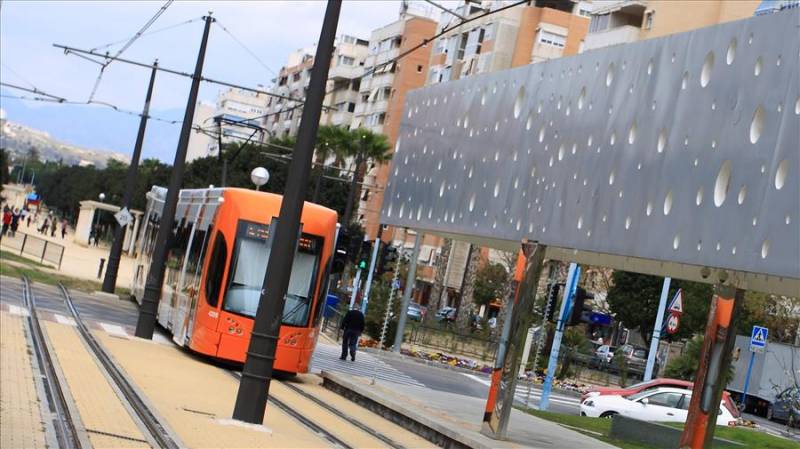
It is quite simple and safe to drive in the Costa Blanca, and generally throughout Spain. The biggest challenge is parking in city/town centres – the vast majority have metred parking and underground carparks. Beware of ‘residents only’ zones.
Car hire is readily available. You’ll find both local and international company offices in most towns, as well as the airports. Insurance is obligatory.
ALSA are the main coach operator which connect the main towns along the Costa Blanca, local firms generally do the urban bus lines or inland routes. Prices are reasonable and fixed, and can be paid on the bus (ALSA tickets can be bought in advance).
Uber and Cabify are strictly controlled in the Valencian Region, not available everywhere, have to be prebooked by phone, and prices are similar to taxis.
TRAM lines in Alicante
Alicante TRAM runs through the city, out to San Juan beach and El Campello. Tram Line 1 is a scenic trip up the Costa Blanca to Benidorm with multiple stops along the way – from here get Line 9 to Altea, Calpe and the northern Costa Blanca (the stretch from Teulada to Dénia is being modernized so is not currently in service).
*See Alicante TRAM itineraries on the official site.
Chart of the 175 Beaches and Coves on Costa Blanca
| TOWN | BLUE FLAG BEACHES | Beaches & Coves |
| L’ALFÁS DEL PI 4 km coastline | Pebble & sand: Racó de l’Albir | Rocky coves: Cala Amerador Cala de la Mina* Cala Metge* |
| ALICANTE 23 km coastline | Sandy beach: San Juan La Albufereta Postiguet Saladares Tabarca Island | Sand beach: Almadraba San Gabriel Rock/sand coves: Cala Sangueta Cabo de la Huerta (Cala Cantalar)* Doggy beach: Agua Amarga |
| ALTEA 7 km coastline | Pebble beach: La Roda L’Espigó Cap Blanch | Pebble beach: Bareta-Mascarat Barra Grande* Cap Negret L’Olla (dog zone) Rocky cove: Raco de Corb Galera-Solsida* |
| BENIDORM 10 km coastline | Sandy beach: Levante Mal Pas Poniente | Rocky cove: Almadrava* Tio Ximo Benidorm Island |
| BENISSA 4 km coastline | Sandy beach: Cala Fustera Sand rock: Bassetes Bay | Rocky cove: El Baladrar L’Advocat Els Pinets La Llobella |
| BENITATXELL 2 km coastline | Rocky cove: Cala Moraig | Rocky cove: Testos* Llebeig |
| CALPE 11 km coastline | Sandy beach: La Fossa – Levante Cantal Roig Arenal Bol | Cove: Cala Mallorqui Cala Morello Cala Manzanera El Racó Calalga Puerto Blanco Les Bassetes El Collao Gasparet Del Penyal* Dog beach: Les Urques |
| EL CAMPELLO 23 km coastline | Sandy beach: Carrer de la Mar Muchavista | Cove: Cala Baeza Cala Carritxal Cala d’Enmig Cala Lanuza Llop Marí Morro Blanc Cala Nostra Les Palmeretes Cala Piteres L’Almerador L’Almadrava Illeta dels Banyets Lloma de Reixes* Doggy beaches: Punta del Riu Barranc d’Aigües |
| DÉNIA 19 km coastline | Sandy beach: Les Deveses Les Bovetes Les Marines Els Molins Punta Raset Marineta Casiana | Sand beach: Almadrava Albaranes Rocky cove: El Trampolí Punta Negra Arenetes La Cala* |
| ELCHE 12 km coastline | Sandy beach: El Altet Arenales del Sol Carabassí* La Marina Les Pesqueres-Rebollo | Sandy beach: El Pinet |
| FINESTRAT 2 km coastline | Sandy beach: La Cala | |
| GUARDAMAR DEL SEGURA 14 km coastline | Sandy Beach: Guardamar Centre La Roqueta El Moncaio | Sand beach: Els Tossals* Els Vivers Babilònia El Camp Les Ortigues |
| XÀBIA (JÁVEA) 25 km coastline | Gravel beach: La Grava Sandy beach: El Arenal Pebble cove: Cala Granadella | Sand stone: Benissero Muntanyar Rocky cove: Cala Blanca Cala Sardinera Barraca (Portitxol) Ambolo* |
| ORIHUELA 16 km of coastline | Sandy beaches: Punta Prima Cala Mosca – Flamenca Cala Estaca – Flamenca Cala Cerrada – La Zenia Cala Bosque – La Zenia La Caleta – Cabo Roig Cala Capitán-Cabo Roig Aguamarina La Glea -Campoamor Barranco Rubio Mil Palmeras | Sandy cove: Calas Cabo Peñas* |
| PILAR DE LA HORADADA 5 km coastline | Sandy beach: Mil Palmeras Los Jesuitas El Conde El Puerto Las Higuericas Rock & sand: Rocamar Coves | Sandy beach: Vistamar Las Villas El Mojón El Río |
| SANTA POLA 15 km coastline | Sandy beach: Calas del Este Varadero Bernabeu Coves Llevant Tamarit* | Coves: La Ermita L’Aljub Coves Cuartel Coves Bancal de L’Arena Doggy beach: Caleta Gossets Sand beach: Gran Playa Playa Lisa La Gola |
| TEULADA / MORAIRA 8 km coastline | Sandy beach: El Portet L´Ampolla Les Platgetes | Rocky cove: Portitxolet L´Andragó Cala Blanc |
| TORREVIEJA 14 km coastline | Sandy beach: Cabo Cervera Los Locos El Cura Los Náufragos Cala Piteras | Sand beach: La Mata Acequion Cala Ferris Rocky coves: Las Calas Sand rock pools: Las Piscinas Doggy beach: Cala Rocío de Mar |
| VILLAJOYOSA 15 km coastline | Sandy beach: Vila Joiosa Centre Pebble: Paradís Bol Nou La Caleta Varadero | Sand & pebble: El Torres Pebble cove: Cala Fonda Tio Roig Estudiants Carritxal Puntes del Morro Racó del Conill* L’Esparrelló* Dog Beach: Xarco |
Costa Blanca Tourism Board Websites
Choose a town and click on the name to see the Tourist Information website.
Our Popular Spanish Travel Guides
Spanish Canary Islands Travel Guide
Travel Guide to the Spanish Canary Islands with everything you need to know about Spain’s holiday isles. The latest travel advice, what to see and do, best beaches and nature activities, how to get there and inter-island transport…
Barcelona 2 Day Itinerary: Seeing the Top Sites
Barcelona city is an open-air museum with a multitude of fascinating things to see. Follow our Barcelona 2 day itinerary through the historic quarter down to the fashionable seafront boulevard.
Visiting Spain and only 3 days to see Granada? Our ultimate Granada guide explains how to see the historical city sites, and the top things to see and do.
Visit Córdoba World Heritage City
Córdoba historic centre is a UNESCO World Heritage City in Southern Spain. Here’s our choice of 25 sites to see and the top things to do when you visit Córdoba.
Seville skyline was backlit by the sunset, the unmistakable Giralda tower and a dozen church spires piercing the sky. We arrived in Seville late afternoon, just in time to see the sun set over the city…
Top Things To Do in Málaga and Costa del Sol
There are so many things to do in Málaga (Spain), lots of history, great food and beaches. Visit Málaga – sun, sea and history on Spain’s Costa del Sol.
Discover the World with![]() the blog with a focus on independent travel
the blog with a focus on independent travel




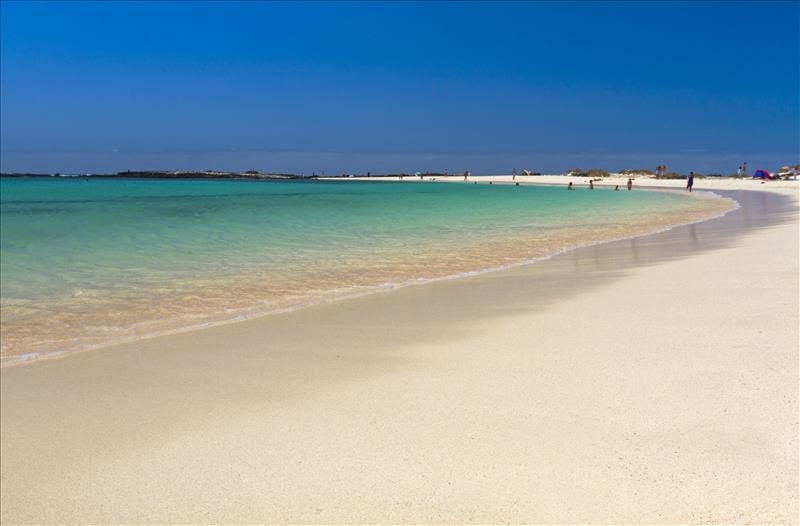
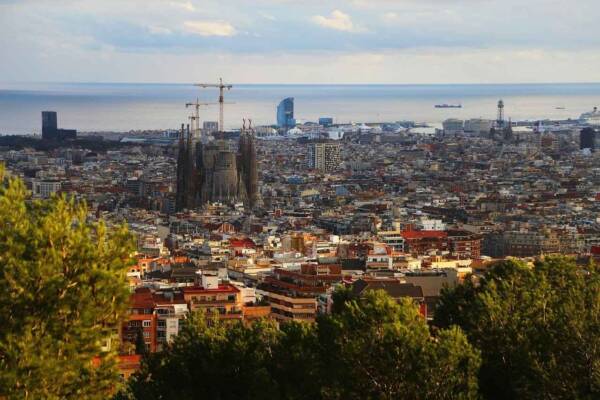
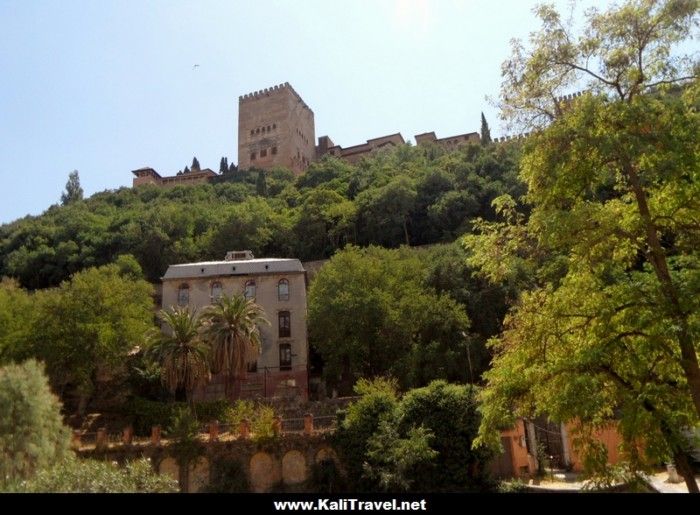
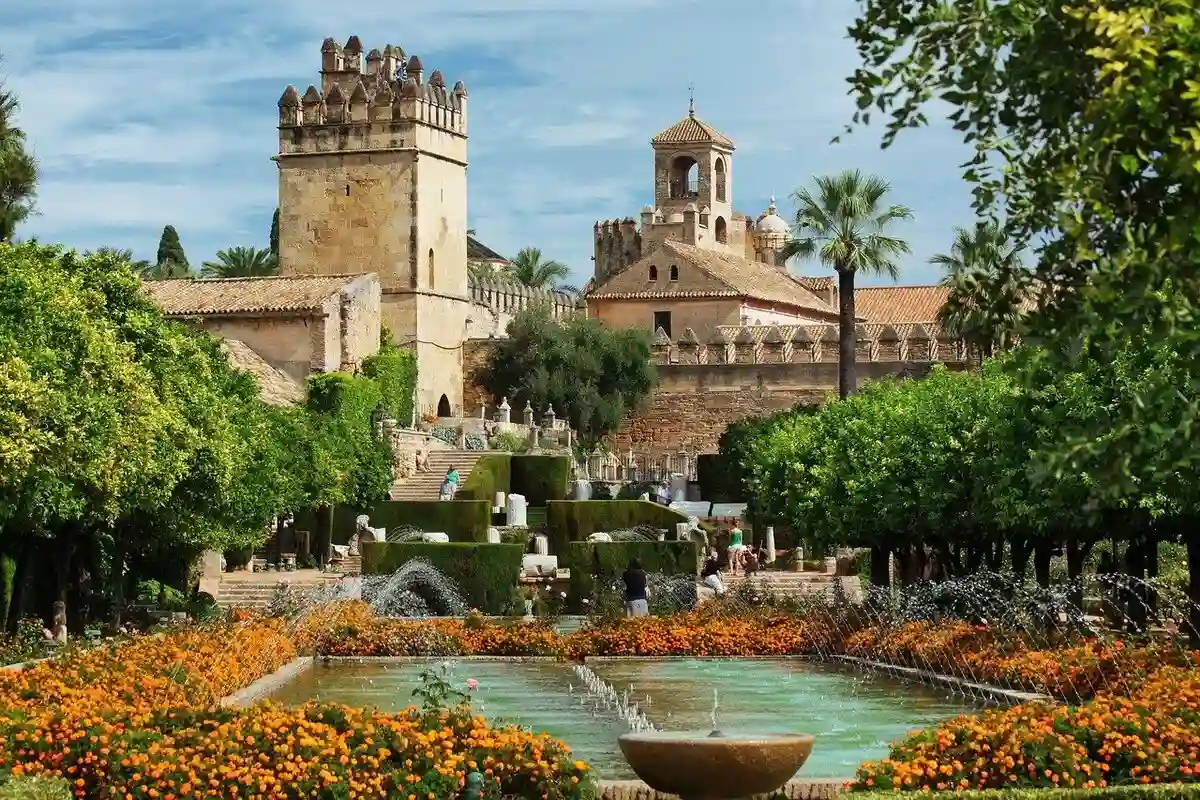
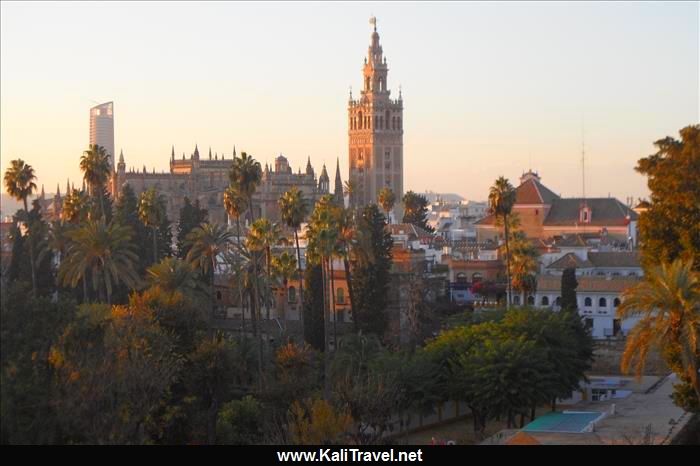
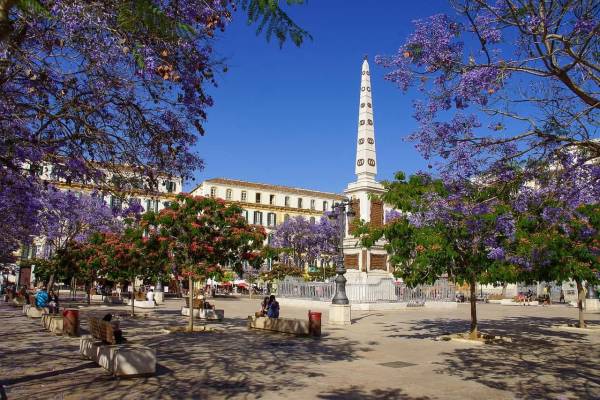
This is a fantastic, comprehensive guide! Will definitely be saving this for future reference.
Glad you like it, I’ve tried to include as much info as possible, particulary about the beaches and coastal resorts. The Costa Blanca is our home when not travelling, so it’s my personal ‘insider guide’.
Thumbs up. This roundup is amazing !
I’ve spent a lot of time along the Costa del Sol but not along the Costa Blanca – it looks amazing! I’ll have to plan a trip here soon.
OMG these beaches are magical. ‘Levante’ Beach looks esp pretty. damn what an epic post. bookmarking.
Wow, what a comprehensive guide to the area. I’d love to travel to Spain soon and if I make it to Costa Blanca, this is clearly an amazing guide!